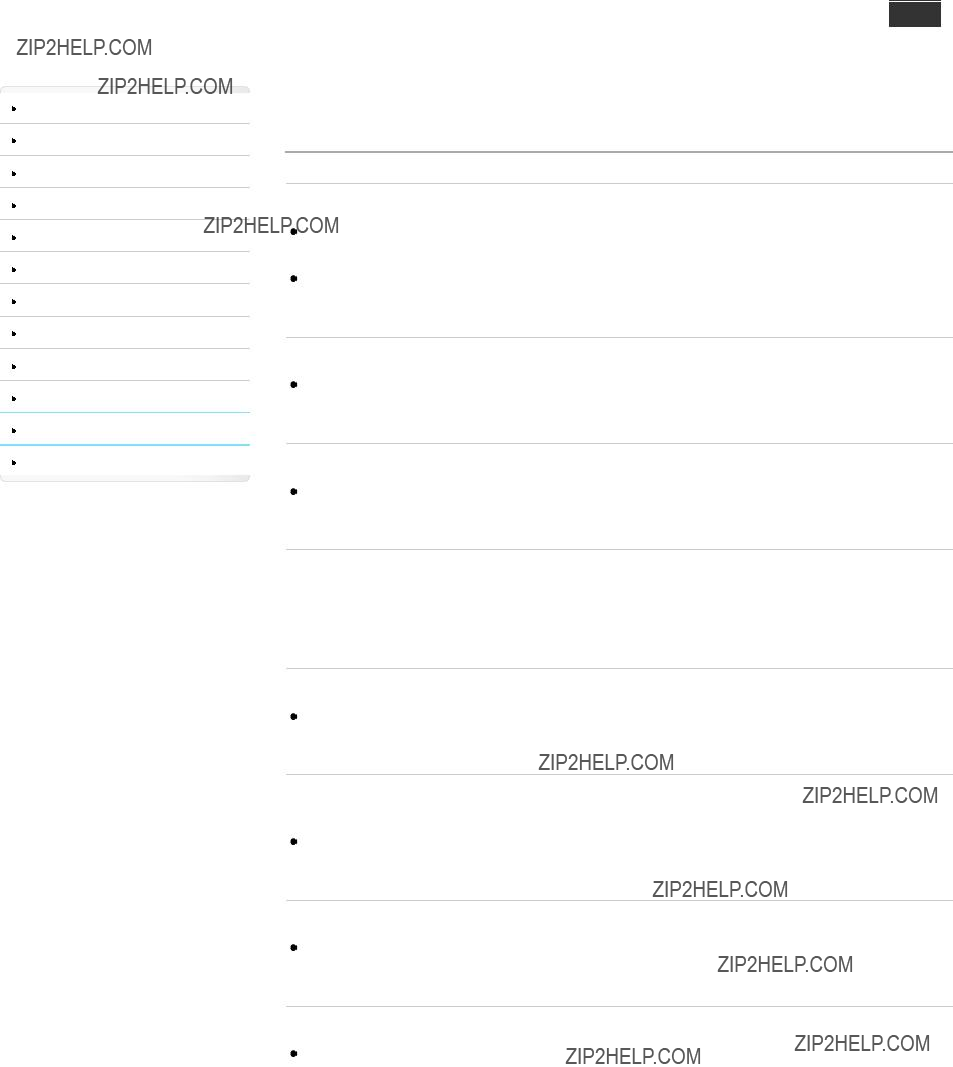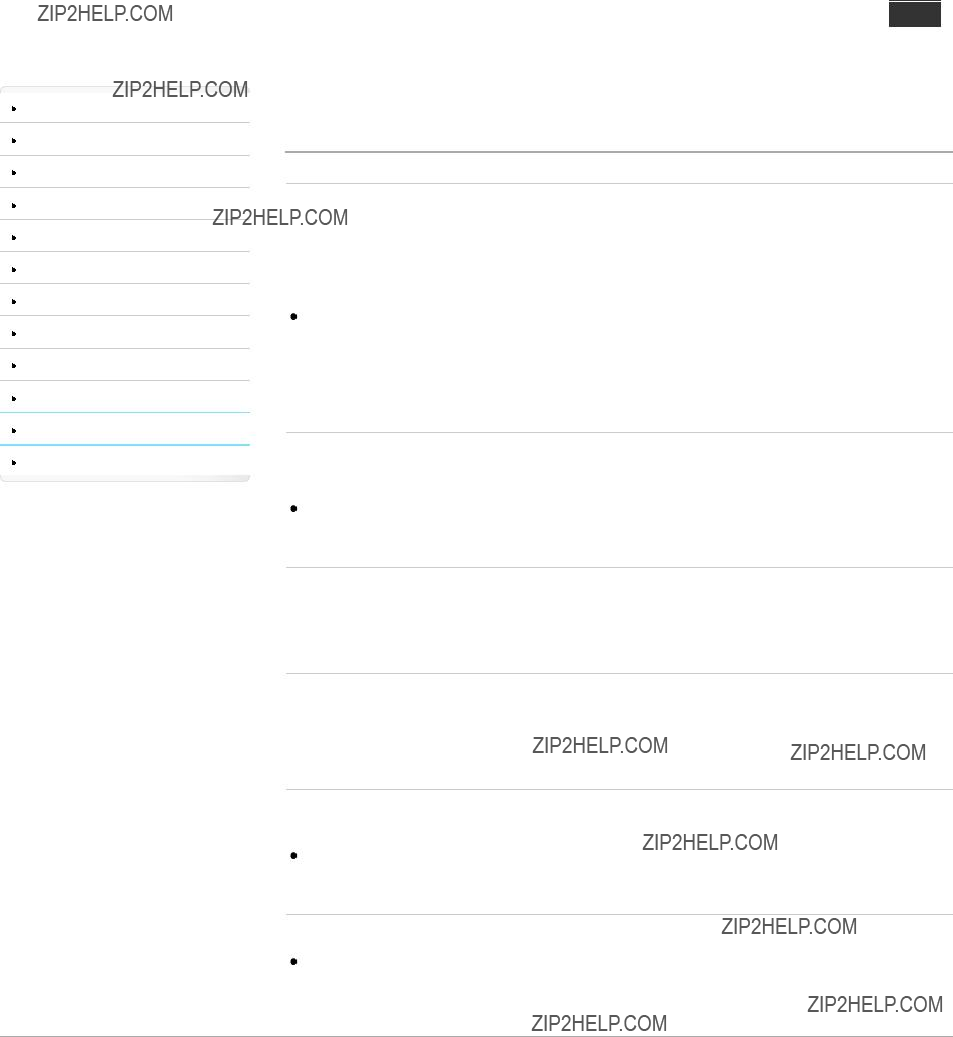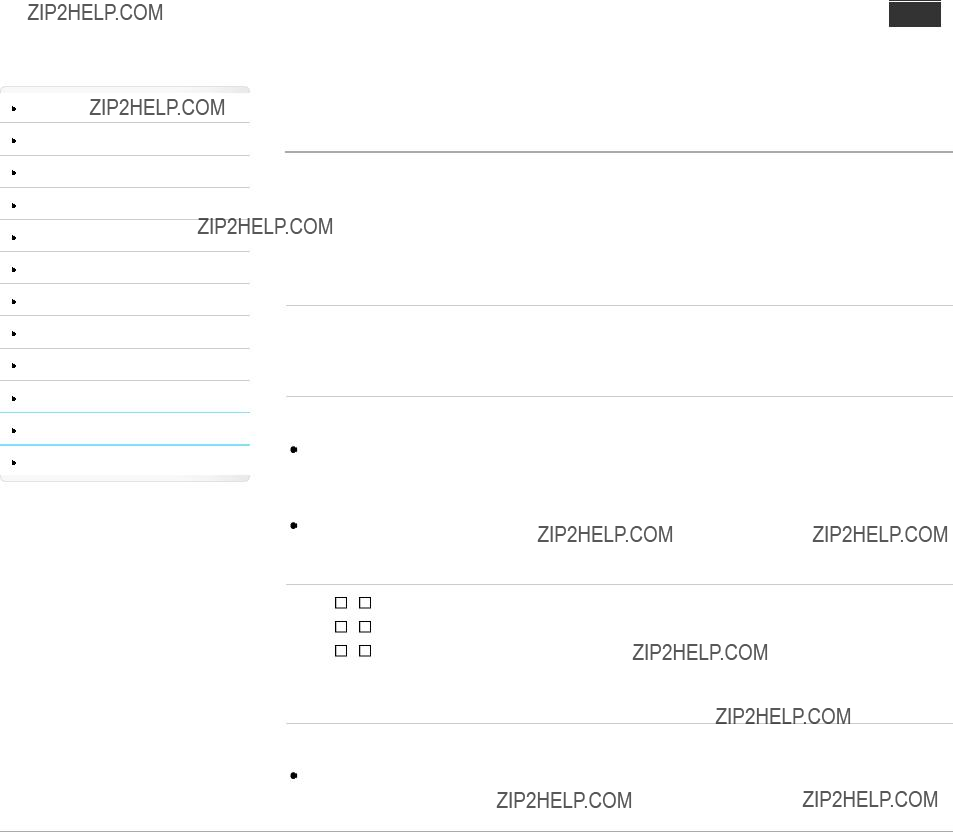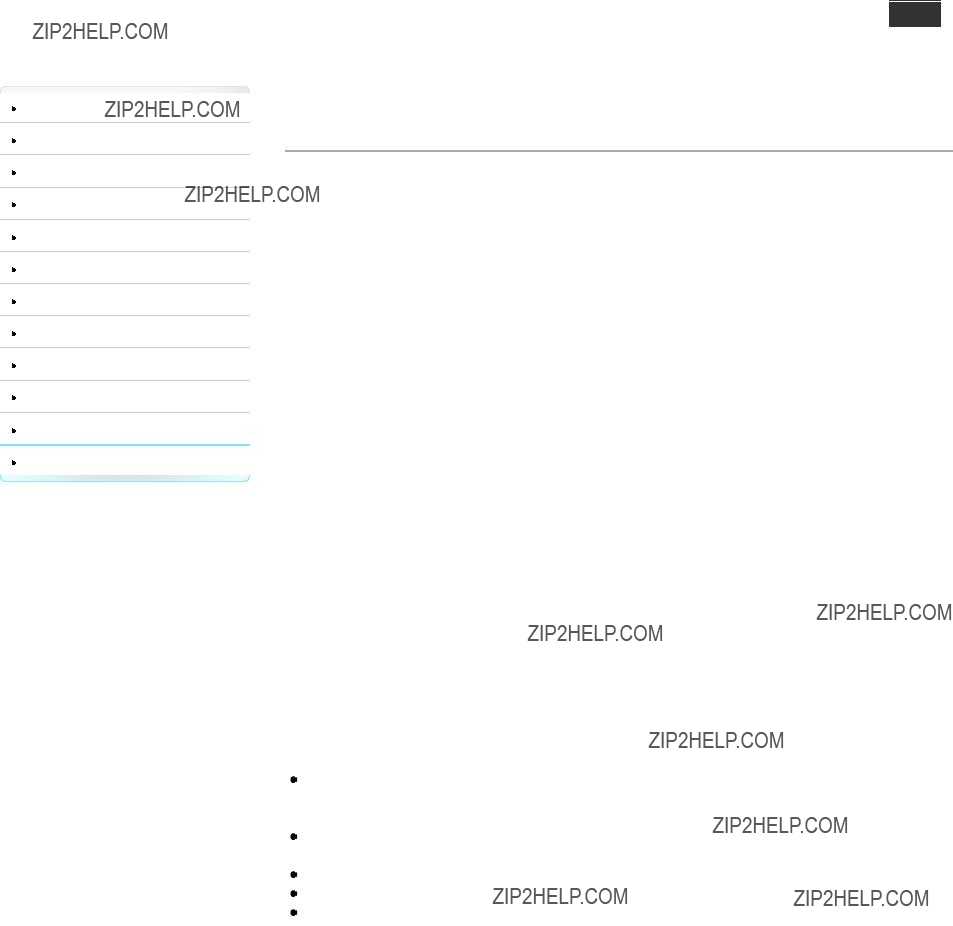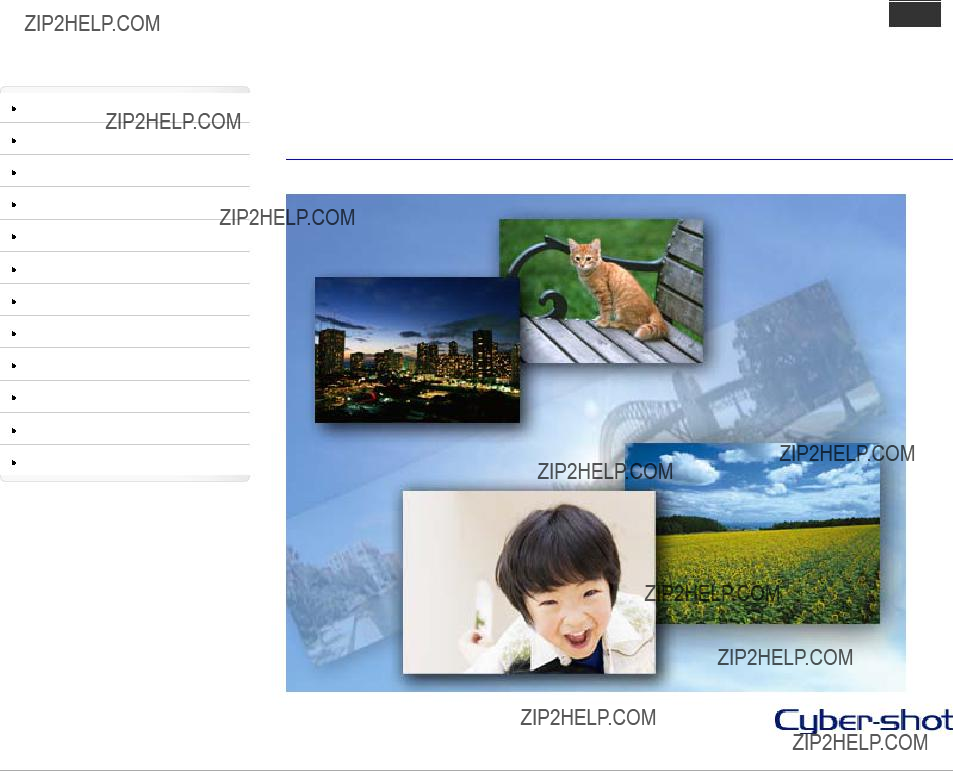
Search Print
Top page
User Guide
Use this manual if you encounter any problems, or have any questions about the camera.
 Back to top
Back to top
Copyright 2013 Sony Corporation
1

Search Print
Top page
User Guide
Use this manual if you encounter any problems, or have any questions about the camera.
 Back to top
Back to top
Copyright 2013 Sony Corporation
1

2

3
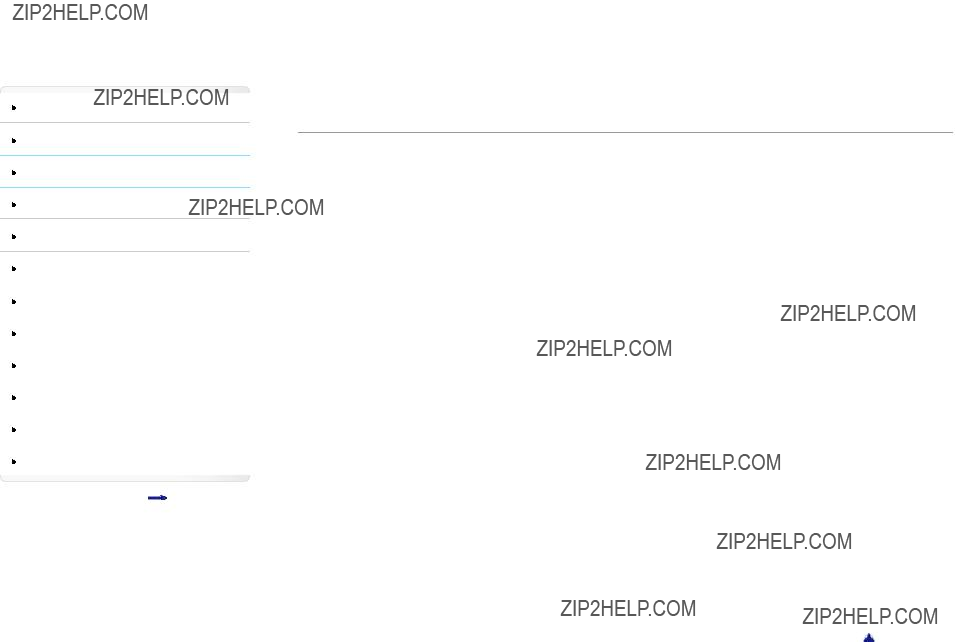
4

Search Print
Top page > Useful shooting functions
 Useful shooting functions
Useful shooting functions
Functions not available for each shooting mode
Functions not available for each shooting mode
MENU items not available for each shooting mode
Using shooting functions
6

 Back to top
Back to top
Copyright 2013 Sony Corporation
7

9

Search Print
Top page > Viewing images on a TV
 Viewing images on a TV
Viewing images on a TV
Viewing an image on a High Definition (HD) TV
Viewing an image on an HD TV using the HDMI Cable (sold separately)
Viewing an image on a ???BRAVIA???
10

11

Situations this camera has difficulty handling
Situations this camera has difficulty handling
 Back to top
Back to top
Copyright 2013 Sony Corporation
13

Search Print
Top page > Precautions / About this camera
 Precautions / About this camera
Precautions / About this camera
Precautions
On the internal rechargeable backup battery
On cleaning
14

Search Print
Top page > Contents list
Contents list
 Before Use
Before Use
How to use this User Guide
Names of parts and list of icons displayed on the screen
List of icons displayed on the screen
Using the strap
Using the shoulder strap
Using the shoulder strap (sold separately)
Using the
 Back to top
Back to top
 Operating the camera
Operating the camera
Operating the camera
How to use the Fn (Function) button
 Back to top
Back to top
 Shooting
Shooting
Shooting still images
Shooting movies
Shooting still images while recording a movie (Dual Rec)
Setting REC mode
15
 Back to top
Back to top
 Viewing
Viewing
Viewing still images
Deleting images
Viewing movies
Viewing panoramic images
Scrolling panoramic images for display
 Back to top
Back to top
 Useful shooting functions
Useful shooting functions
Functions not available for each shooting mode
Functions not available for each shooting mode
MENU items not available for each shooting mode
Using shooting functions
16
 Back to top
Back to top
 Useful viewing functions
Useful viewing functions
Functions not available for each view mode
MENU items not available for each view mode
Playback menu
17
 Back to top
Back to top
 Changing settings
Changing settings
Memory Card Tool menu
Clock setup menu
Setup menu
PAL/NTSC Selector (only for 1080
 Back to top
Back to top
18
 Viewing images on a TV
Viewing images on a TV
Viewing an image on a High Definition (HD) TV
Viewing an image on an HD TV using the HDMI Cable (sold separately)
Viewing an image on a ???BRAVIA???
Viewing an image on a ???BRAVIA???
 Back to top
Back to top
 Using with your computer
Using with your computer
Recommended computer environment
Recommended computer environment
Using the software
???PlayMemories Home??? (Windows) Installing ???PlayMemories Home??? (Windows) Software for Mac
Installing ???Image Data Converter??? (Windows / Mac)
Importing images to a computer
Connecting the camera to the computer
Importing images to a computer
To disconnect your camera from the computer
Creating a disc of movies
Selecting a method for creating a disc of movies
 Back to top
Back to top
 Printing
Printing
Printing still images
 Back to top
Back to top
 Troubleshooting
Troubleshooting
If you have problems
Troubleshooting
Warning indicators and messages
19

Situations this camera has difficulty handling
Situations this camera has difficulty handling
 Back to top
Back to top
 Precautions / About this camera
Precautions / About this camera
Precautions
On the internal rechargeable backup battery
On cleaning
Number of still images and recordable time of movies
Using the camera abroad
About this camera
Trademarks
 Back to top
Back to top
Copyright 2013 Sony Corporation
20
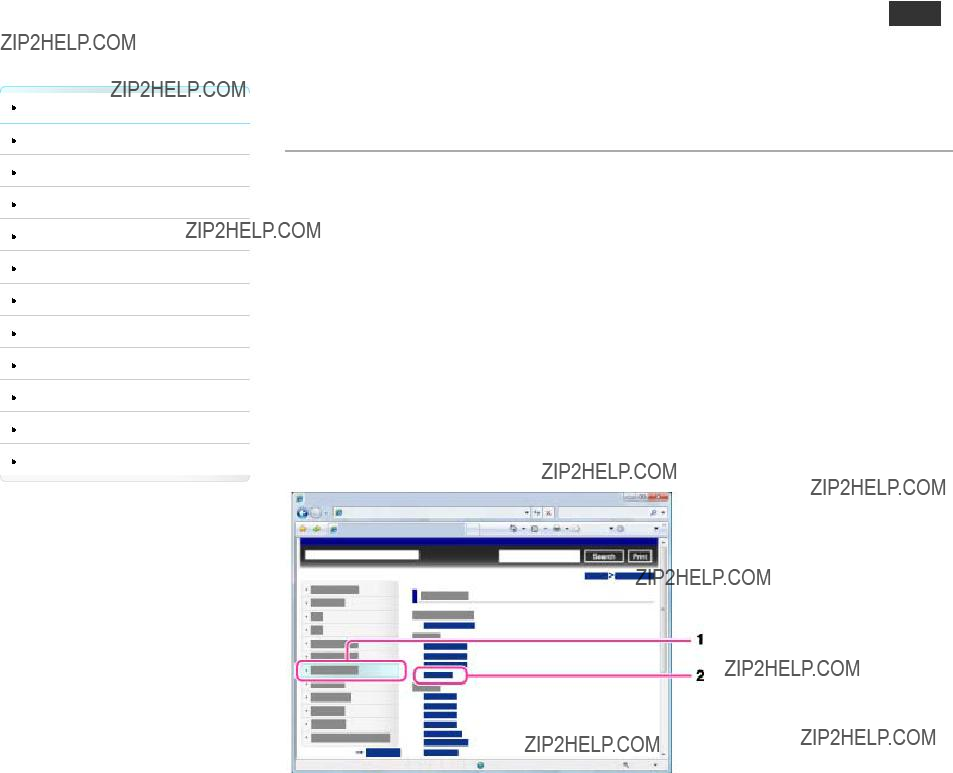
Search Print
Top page > Before Use > How to use this User Guide > How to use this User Guide
How to use this User Guide
 Selecting a topic to display
Selecting a topic to display
 Searching a topic by keyword
Searching a topic by keyword
 Returning to a previous page
Returning to a previous page
 Printing out a page
Printing out a page
 Marks and notations used in this User Guide
Marks and notations used in this User Guide
The images used as examples in this User Guide are reproduced images, and are not actual images shot using this camera.
 Selecting a topic to display
Selecting a topic to display
The following illustrations take Internet Explorer 7 as an example.
1.Click a title in the side bar on the left of the browser window. The title???s topic list appears in the right pane.
2.Click a topic title in the list.
Descriptions appear in the right pane.
21

Changing the font size
Change the font size by changing the setting of your web browser. For how to change the font size setting, refer to the Help of your web browser.
 Searching a topic by keyword
Searching a topic by keyword
Enter the keyword in the search window, then click the [Search] button.
 Returning to a previous page
Returning to a previous page
Use the browser???s back button to return to a previously viewed page, or use the breadcrumb trail navigation (A) to display the desired page.
 Printing out a page
Printing out a page
Click the [Print] button to print out the page you are viewing.
22

 Marks and notations used in this User Guide
Marks and notations used in this User Guide
In this User Guide, the sequence of operations is shown by arrows ( ) (A).
) (A).
Operate the camera in the order indicated.
Icons in the operating procedure sentences appear when the camera is in its default settings. The default setting is indicated by  .
.
indicates information that is useful to know.
 Back to top
Back to top
Copyright 2013 Sony Corporation
23

Search Print
Top page > Before Use > Names of parts and list of icons displayed on the screen > Names of parts
Names of parts
Shutter button
Mode dial
For shooting: W/T (zoom) lever
For viewing: Index/Playback zoom lever
Power/Charge lamp
ON/OFF (Power) button
Multi interface shoe*
Flash
Do not cover the flash with your fingers.
When using the flash, the flash pops up automatically. If not using the flash, press it down manually.
Microphone
Hook for strap
Control Ring
Lens
* For details on compatible accessories for the multi interface shoe, visit the Sony web site, or consult your Sony dealer or local authorized Sony service facility. You can also use accessories that are compatible with the accessory shoe. Operations with other manufacturers??? accessories are not guaranteed.
24

Light sensor
LCD screen
 Adjust the screen for a comfortable viewing angle to shoot in various positions.
Adjust the screen for a comfortable viewing angle to shoot in various positions.
Fn (Function) button
MOVIE (Movie) button
Multi Terminal
 Supports Micro USB compatible device.
Supports Micro USB compatible device.
HDMI micro jack
MENU button
Control wheel
 (Playback) button
(Playback) button
 /
/
25

Battery insertion slot
Battery eject lever
Tripod socket hole
Access lamp
Memory card slot
Battery/Memory card cover
 (N Mark)
(N Mark)
Touch the mark when you connect the camera to a smartphone equipped with the NFC function. NFC (Near Field Communication) is an international standard of the
Speaker
 Back to top
Back to top
Copyright 2013 Sony Corporation
26

Top page > Before Use > Names of parts and list of icons displayed on the screen > List of icons displayed on the screen
List of icons displayed on the screen
 List of shooting mode icons
List of shooting mode icons
 List of viewing mode icons
List of viewing mode icons
Icons are displayed on the screen to indicate camera status.
You can change the screen display using  on the control wheel.
on the control wheel.
 List of shooting mode icons
List of shooting mode icons

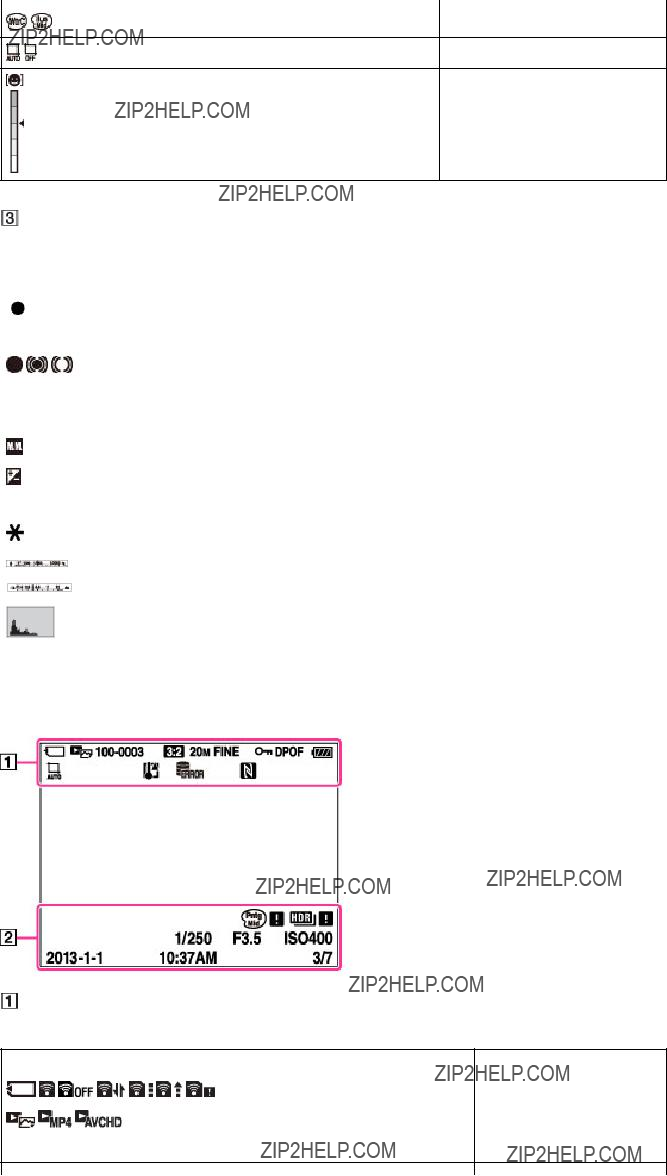
Picture Effect
Auto Object Framing
Smile Detection Sensitivity indicator
 List of viewing mode icons
List of viewing mode icons
29

20M/18M/17M/13M/10M/7.5M/6.5M/5.0M/4.2M/3.7M/3.2M/VGA
Aspect ratio of still images
Image size of still images
Image quality of still images
Frame rate of movies
Recording mode of movies
File Format
Protect
Print order (DPOF)
Battery charge remaining
Low battery warning
Overheating warning
Database file full/Database file error
NFC active
Airplane Mode
Auto Object Framing image
 Back to top
Back to top
Copyright 2013 Sony Corporation
30

Search Print
Top page > Before Use > Using the strap > Using the wrist strap
Using the wrist strap
Attach the strap and place your hand through the loop to prevent the camera from damage by being dropped.
31

Precautions / About this camera
Notes
 Shoulder strap is sold separately.
Shoulder strap is sold separately.
 Back to top
Back to top
Copyright 2013 Sony Corporation
32
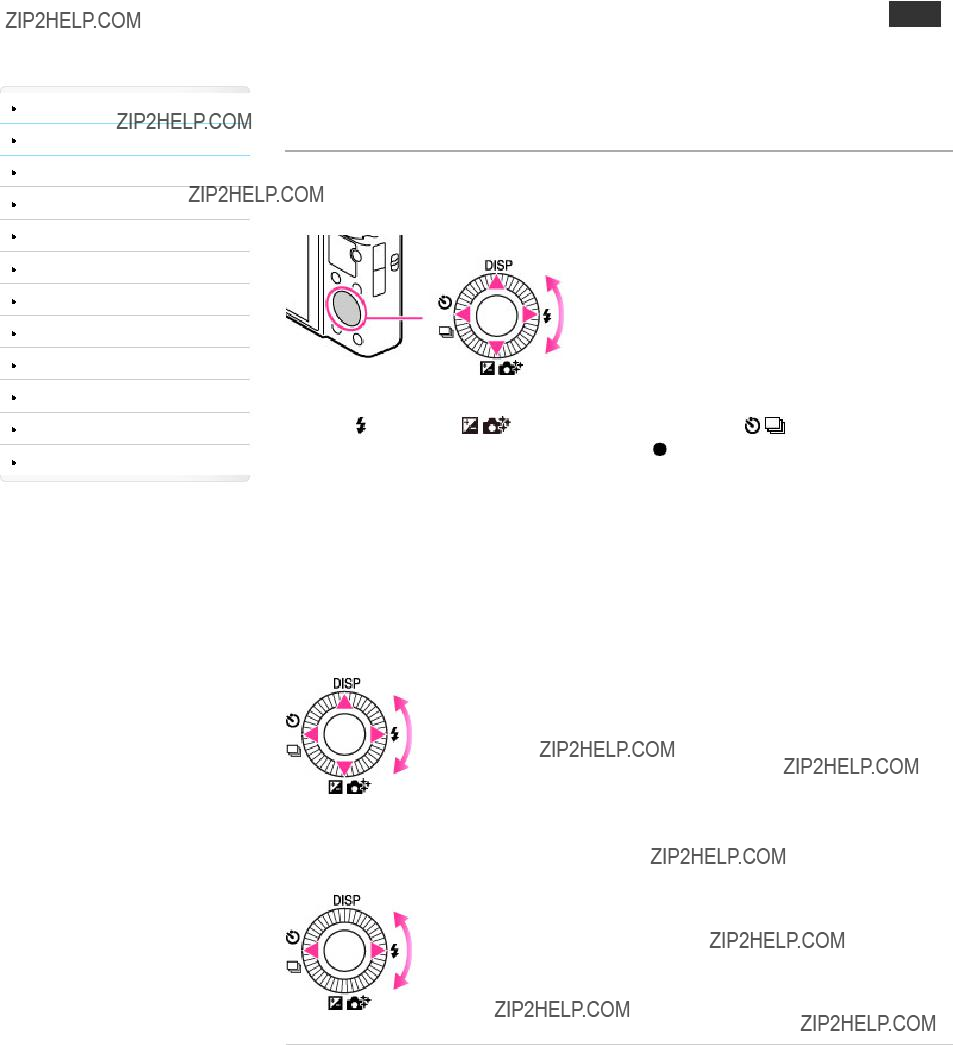
Search Print
Top page > Operating the camera > Operating the camera > Using the control wheel
Using the control wheel
 Moving the selection frame on the MENU screen, etc.
Moving the selection frame on the MENU screen, etc.
 Selecting an image to be played back
Selecting an image to be played back
The following functions are located on the up/down/right/left side of the control wheel:  (Display
(Display
Press the control wheel toward each icon to enter the setup screen for each function.
Turn the control wheel or press the up/down/right/left side of the wheel following the screen to move the selection frame.
Press  in the center of the control wheel to set the selected item.
in the center of the control wheel to set the selected item.
 Moving the selection frame on the MENU screen, etc.
Moving the selection frame on the MENU screen, etc.
Turn the control wheel or press the up/down/right/left side of the wheel to move the selection frame. In some modes, you can also move the selection frame by turning the control wheel.
 Selecting an image to be played back
Selecting an image to be played back
Press the right or left side of the control wheel, or turn the wheel to play back the next/previous image.
Related Topic
Func. of Center Button
Func. of Left Button
35

Func. of Right Button
 Back to top
Back to top
Copyright 2013 Sony Corporation
36

Top page > Operating the camera > Operating the camera > How to use Control Ring
How to use Control Ring
You can change the setting needed for each REC mode immediately by turning the control ring. In the default setting, the function that the camera recommends is assigned, but you can change the function to be assigned.
A: Control Ring
B: Active Control Ring function
C: Active control wheel function
For details on how to assign the functions, see ???Control Ring.??? [Details]
Related Topic
Control Ring
 Back to top
Back to top
Copyright 2013 Sony Corporation
37

Top page > Operating the camera > Operating the camera > How to use the Fn (Function) button
How to use the Fn (Function) button
You can recall
1. Press the Fn (Function) button in shooting mode.
2. Select the desired function by pressing the Fn (Function) button repeatedly. You can also select the desired function using  /
/ on the control wheel.
on the control wheel.
3. Set the desired mode or value by turning the control wheel or the Control Ring.
 If the selected function setting can be further
If the selected function setting can be further  on the control wheel to
on the control wheel to
display the setting screen.
To customize functions that are recalled when pressing the Fn (Function) button, see ???Function Button.??? [Details]
Related Topic
Function Button
 Back to top
Back to top
Copyright 2013 Sony Corporation
38

1. Press the MENU button to display the Menu screen.
Precautions / About this camera
2. Select the desired Menu screen page using  /
/ on the control wheel.
on the control wheel.
3. Select the desired item using  /
/ or by turning the control wheel, and then press
or by turning the control wheel, and then press  .
.
4. Select the desired item following the instructions on the screen, and then press  to confirm.
to confirm.
 Back to top
Back to top
Copyright 2013 Sony Corporation
39

Search Print
Top page > Shooting > Shooting still images > Shooting still images
Shooting still images
1. Set the mode dial to  (Intelligent Auto).
(Intelligent Auto).
2. Hold the camera steady as illustrated.
 Do not cover the flash with your fingers.
Do not cover the flash with your fingers.
3.Press the shutter button halfway down to focus.
When the image is in focus, a beep sounds and the indicator ( or
or  ) lights.
) lights.
Focus indicator
 lights: Image is in the focus.
lights: Image is in the focus.
 lights: Image is in the focus. The focused position will change to suit the motion of the subject.
lights: Image is in the focus. The focused position will change to suit the motion of the subject.
 lights: The camera is in the progress of focusing.
lights: The camera is in the progress of focusing.  flashes: The focusing is failed.
flashes: The focusing is failed.
The shortest shooting distance is approximately 5 cm (0.16 ft) (W), 55 cm (1.8 ft) (T) (from the lens).
40
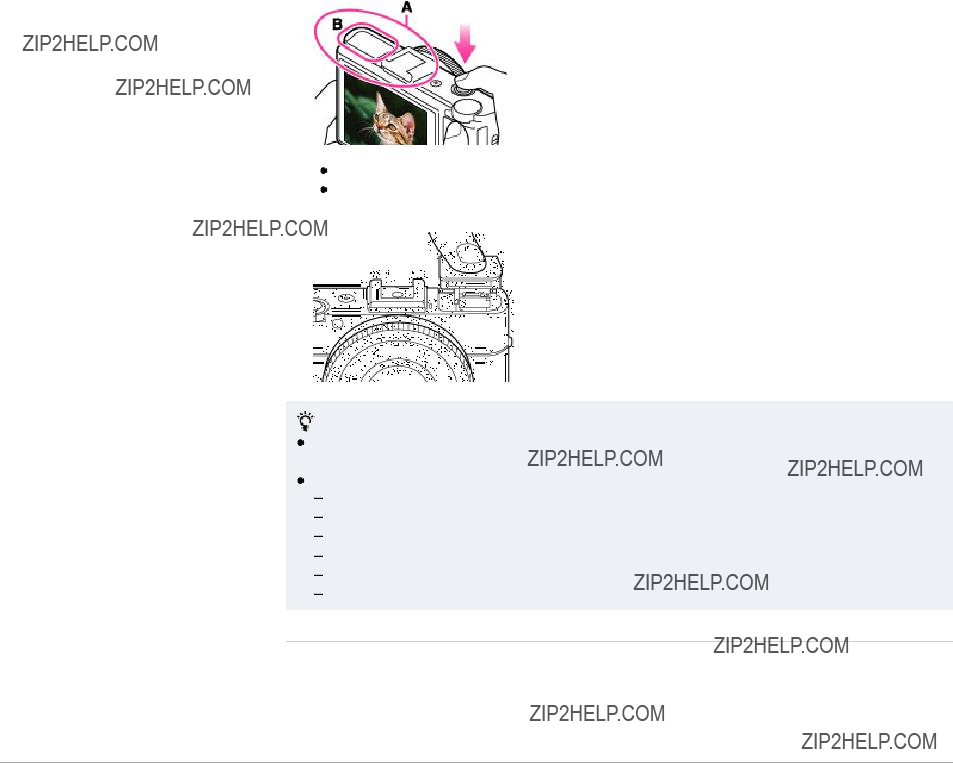
4. Press the shutter button fully down.
Do not cover part (A), shown in the illustration.
When using the flash, the flash (B) pops up automatically. If not using the flash, press it down manually.
If you shoot a still image of a subject that is difficult to focus on
When the camera cannot focus automatically, the focus indicator flashes and the beep does not sound. Either recompose the shot or change the focus setting. [Details]
Focusing may be difficult in the following situations: It is dark and the subject is distant.
The contrast between the subject and the background is poor. The subject is seen through glass.
The subject is moving quickly.
There is reflective light or shiny surfaces.
The subject is backlit or there is a flashing light.
Related Topic
Viewing still images
Image Size
 Back to top
Back to top
Copyright 2013 Sony Corporation
41

Search Print
Top page > Shooting > Shooting still images > Zoom (Still images)
Zoom (Still images)
 Available zoom
Available zoom
 Zoom scale
Zoom scale
Enlarge images with the W/T (zoom) lever when shooting. The camera???s optical zoom function can enlarge images up to 3.6??.
Optical zoom allows you to enlarge an image without deteriorating its original quality.
1.Set the camera to shooting mode.
2.Turn the W/T (zoom) lever.
 Turn the lever to the T side to zoom in, or to the W side to zoom out.
Turn the lever to the T side to zoom in, or to the W side to zoom out.
When zoom is assigned to the Control Ring, you can zoom in and zoom out also using the Control Ring. [Details]
Notes
 Zoom is locked to the W side in [Sweep Panorama] mode.
Zoom is locked to the W side in [Sweep Panorama] mode.
 Available zoom
Available zoom
The camera achieves a high magnification zoom scale by combining zoom methods. The icon and zoom bar on the screen change in accordance with the zoom you use.
Optical zoom range
The camera???s optical zoom function can enlarge images up to 3.6??.
Zoom range other than optical zoom Zoom with the original image quality
When [Image Size] is set to other than [L], you can shoot still images with no deterioration in the original image quality, even if the optical zoom scale exceeds 3.6?? magnification, by trimming image processing.
( ) [Clear Image Zoom]
) [Clear Image Zoom]
Zoom with close to the original image quality [Details]
( ) [Digital Zoom]
) [Digital Zoom]
Less than the original image quality [Details]
42

 Zoom scale
Zoom scale
The supported zoom scales are different depending on the settings or the image size. The table below summarizes the zoom scales when [Clear Image Zoom] and [Digital Zoom] are set to [On], and [Aspect Ratio] is set to [3:2].
* The maximum zoom scale is the magnification when [Clear Image Zoom] is set to [On] and [Digital Zoom] is set to [On]. The maximum zoom scale varies depending on the settings. [Details]
Notes
The default setting for [Clear Image Zoom] is [Off]. [Details]
The default setting for [Digital Zoom] is [Off]. Set [Digital Zoom] to [On] to enlarge images even with deterioration. [Details]
The default setting for [Image Size] is [L]. To change the zoom scale, change [Image Size]. [Details] When [Image Size] is set to [VGA], [Digital Zoom] is limited; the maximum zoom scale is 54??. Zoom functions other than the optical zoom are not available when shooting in the following situations:
When the Smile Shutter function is activated When [Drive Mode] is set to
When [Quality] is set to [RAW] or [RAW & JPEG]
The Face Detection function does not operate when you use other than the optical zoom.
 Back to top
Back to top
Copyright 2013 Sony Corporation
43

Top page > Shooting > Shooting movies > Shooting movies
Shooting movies
You can start recording a movie by pressing the MOVIE (Movie) button, regardless of the position of the mode dial.
1. Press the MOVIE button to start recording.
 To adjust the shutter speed and aperture value to the desired settings, set the mode dial to
To adjust the shutter speed and aperture value to the desired settings, set the mode dial to  (Movie).
(Movie).
2. Press the MOVIE button again to stop recording.
Notes
The sound of the lens and lever operating will be recorded when the zoom function operates while shooting a movie. The sound of the MOVIE button operating may also be recorded when you press the MOVIE button to stop recording.
Continuous shooting is possible for approximately 29 minutes at one time at the camera???s default settings and when the temperature is approximately 25??C (77??F). When movie recording is finished, you can restart recording by pressing the MOVIE button again. Recording may stop to protect the camera depending on the ambient temperature.
Related Topic
Zoom (Movies)
Shooting still images while recording a movie (Dual Rec)
Movie
File Format
 Back to top
Back to top
Copyright 2013 Sony Corporation
44

Search Print
Top page > Shooting > Shooting movies > Zoom (Movies)
Zoom (Movies)
Enlarge images with the W/T (zoom) lever when shooting. The camera???s optical zoom function can enlarge images up to 3.6??.
Optical zoom allows you to enlarge an image without deteriorating its original quality.
1.Set the camera to shooting mode.
2.Turn the W/T (zoom) lever.
 Turn the lever to the T side to zoom in, or to the W side to zoom out.
Turn the lever to the T side to zoom in, or to the W side to zoom out.
When zoom is assigned to the Control Ring, you can zoom in and zoom out also using the Control Ring. [Details]
 Available zoom
Available zoom
When zooming, you can exceed the 3.6?? optical zoom. During movie shooting, the digital zoom always operates when the zoom scale exceeds 3.6??, even if [Digital Zoom] is set to [Off]. The camera can enlarge images up to 14??.
Optical zoom range
Optical zoom: The camera???s optical zoom function can enlarge images up to 3.6??.
Zoom range other than optical zoom
[Digital Zoom]: Less than original image quality [Details]
Notes
[Clear Image Zoom] is not available while recording movies.  The camera zooms slowly while recording movies.
The camera zooms slowly while recording movies.
 Back to top
Back to top
Copyright 2013 Sony Corporation
45

3. Press the MOVIE button to stop recording the movie.
 Using the Smile Shutter while recording movies
Using the Smile Shutter while recording movies
Set the mode dial to  (Movie) and press the MOVIE button after activating the Smile Shutter.
(Movie) and press the MOVIE button after activating the Smile Shutter.
A still image is shot automatically when a smile is detected while recording movies.
Notes
When [Record Setting] is set to [60p 28M(PS)]/[50p 28M(PS)], you cannot use the Dual Rec. The sound of the shutter button operating may be recorded.
Flash is not available for shooting still images during movie recording.
The size of still image that can be shot while recording a movie varies depending on the movie recording setting. For details, see ???Image Size(Dual Rec).??? [Details]
 When Dual Rec recording is unavailable, the
When Dual Rec recording is unavailable, the  (still image recording unavailable) indicator appears on the screen.
(still image recording unavailable) indicator appears on the screen.
 Back to top
Back to top
Copyright 2013 Sony Corporation
46

Related Topic
Intelligent Auto
Superior Auto
Program Auto
Aperture Priority
Shutter Priority
Manual Exposure
Memory recall
Movie
Sweep Panorama
Scene Selection
 Back to top
Back to top
Copyright 2013 Sony Corporation
48

Search Print
Top page > Shooting > Setting REC mode > Intelligent Auto
Intelligent Auto
 Scene Recognition
Scene Recognition
 Features of Auto shooting modes
Features of Auto shooting modes
Allows you to shoot still images with the settings adjusted automatically.
1.Set the mode dial to  (Intelligent Auto).
(Intelligent Auto).
2.Shoot with the shutter button.
 Scene Recognition
Scene Recognition
Scene Recognition operates in [Intelligent Auto] mode. This function lets the camera automatically recognize the shooting conditions and shoot the image.
In Scene Recognition, the position of an icon displayed on the screen differs depending on whether the camera recognizes a scene or condition. If the camera recognizes a scene, icons and guides such as
 (Portrait),
(Portrait),  (Baby),
(Baby),  (Night Portrait),
(Night Portrait),  (Night Scene),
(Night Scene),  (Backlight Portrait),
(Backlight Portrait),  (Backlight),
(Backlight),  (Landscape),
(Landscape),  (Macro),
(Macro),  (Spotlight) or
(Spotlight) or  (Low Brightness) are displayed on the first line. If the
(Low Brightness) are displayed on the first line. If the
camera recognizes a condition, icons such as  (Tripod),
(Tripod),  (Move) or
(Move) or  (Walk) are displayed on the second line. The camera may recognize both a scene and condition, or just one.
(Walk) are displayed on the second line. The camera may recognize both a scene and condition, or just one.
Notes
Scene Recognition function does not operate when you use zoom functions other than the optical zoom.
These scenes may not be recognized depending on the situation.
 If the environment causes vibrations to be transferred to the camera even when the camera is fixed to a tripod,
If the environment causes vibrations to be transferred to the camera even when the camera is fixed to a tripod,  (Tripod) condition may not be recognized.
(Tripod) condition may not be recognized.
 Sometimes a slow shutter results when
Sometimes a slow shutter results when  (Tripod) and
(Tripod) and  (Night Scene) condition are recognized at the same time. Keep the camera still during shooting.
(Night Scene) condition are recognized at the same time. Keep the camera still during shooting.
 Features of Auto shooting modes
Features of Auto shooting modes
In [Superior Auto] mode, the camera shoots a
[Program Auto] mode allows you to change various shooting settings, such as the white balance or ISO settings.
49

Notes
In [Intelligent Auto] mode, you may be unable to shoot low light or backlit scenes clearly.
In [Superior Auto] mode, it takes some time to record an image, because the camera overlays the images.
Related Topic
Functions not available for each shooting mode
MENU items not available for each shooting mode
 Back to top
Back to top
Copyright 2013 Sony Corporation
50

Search Print
Top page > Shooting > Setting REC mode > Superior Auto
Superior Auto
The camera combines Scene Recognition and
For details on the Scene Recognition function, see ???Scene Recognition.??? [Details]
1.Set the mode dial to  (Superior Auto).
(Superior Auto).
2.Shoot with the shutter button.
The camera shoots burst images when needed and overlays the multiple images. By overlaying the images, the camera records an image with less subject blur and noise.
 What is the difference between [Superior Auto] mode and [Intelligent Auto] mode?
What is the difference between [Superior Auto] mode and [Intelligent Auto] mode?
In [Superior Auto] mode, the camera shoots burst images based on the recognized scene, then creates a composite of the burst images (Overlay shooting).
The camera automatically corrects the backlight and reduces the noise by overlaying images, so a
 : Scene Recognition
: Scene Recognition
 Night Scene
Night Scene
 Night Portrait
Night Portrait
 Backlight
Backlight
 Backlight Portrait
Backlight Portrait
 Landscape
Landscape
 Macro
Macro
 Portrait
Portrait
 Baby
Baby
 Spotlight
Spotlight
 Low Brightness
Low Brightness
 Tripod
Tripod
 Move
Move
 : Overlaying processing
: Overlaying processing
51


 Backlight Correction HDR
Backlight Correction HDR
The camera automatically selects an overlaying mode based on the recognized scene, and  (overlay) appears on the screen.
(overlay) appears on the screen.
Notes
When the camera overlays the images, it takes more time to record an image.
In low light conditions such as night scenes, set [Flash Mode] to [Flash Off] to achieve the optimal effect of the overlaid images.
 When [Quality] is set to [RAW] or [RAW & JPEG], the camera does not overlay the images.
When [Quality] is set to [RAW] or [RAW & JPEG], the camera does not overlay the images.
Related Topic
Functions not available for each shooting mode
MENU items not available for each shooting mode
 Back to top
Back to top
Copyright 2013 Sony Corporation
52

Search Print
Top page > Shooting > Setting REC mode > Program Auto
Program Auto
Allows you to shoot with the exposure adjusted automatically (both the shutter speed and the aperture value). Also you can select various settings using the menu.
1.Set the mode dial to  (Program Auto).
(Program Auto).
2.Shoot with the shutter button.
 Program shift
Program shift
You can change the aperture (F value) and shutter speed combination while keeping the exposure fixed when flash is set to [Flash Off].
1.Turn the control wheel.
??? ??? on the screen changes to ???
??? on the screen changes to ??? ??? and the shooting mode changes to program shift.
??? and the shooting mode changes to program shift.
2.Turn the control wheel to select the aperture (F value) and shutter speed combination.
3.Shoot with the shutter button.
 To cancel program shift, turn the control wheel to return the indication to ???
To cancel program shift, turn the control wheel to return the indication to ??? ???.
???.
Notes
According to the brightness of the environment, the program shift may not be used.
Set the mode dial to the one other than ??? ??? or turn off the power to cancel the setting you made. When the brightness changes, the aperture (F value) and shutter speed also change while maintaining the shift amount.
??? or turn off the power to cancel the setting you made. When the brightness changes, the aperture (F value) and shutter speed also change while maintaining the shift amount.
 When [Flash Mode] setting is changed, program shift is canceled.
When [Flash Mode] setting is changed, program shift is canceled.
Related Topic
Functions not available for each shooting mode MENU items not available for each shooting mode
 Back to top
Back to top
Copyright 2013 Sony Corporation
53
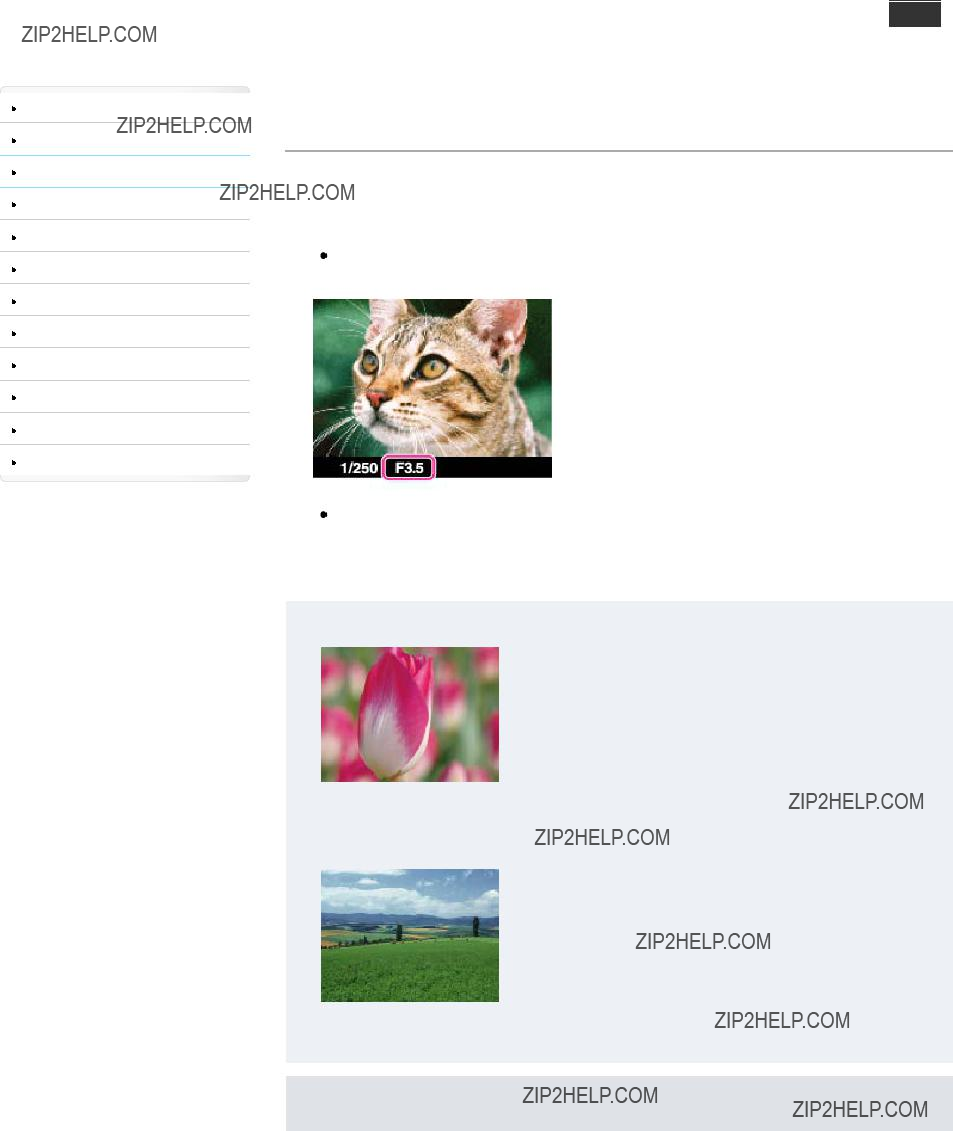
Search Print
Top page > Shooting > Setting REC mode > Aperture Priority
Aperture Priority
Allows you to adjust the focus range or degree of background defocus.
1.Set the mode dial to  (Aperture Priority).
(Aperture Priority).
2.Turn the control wheel to select the aperture (F value).
When [Aperture Priority] is assigned to the Control Ring, you can set it also using the Control Ring. [Details]
You can select an aperture (F value) from F1.8 to F11. (When you turn the W/T (zoom) lever to the T side, the minimum aperture (F value) will increase.)
 The shutter speed is automatically adjusted from 1/2000 seconds to 8 seconds. 3. Shoot with the shutter button.
The shutter speed is automatically adjusted from 1/2000 seconds to 8 seconds. 3. Shoot with the shutter button.
 About aperture
About aperture
The lower the aperture (F value), the wider the hole that lets light pass through. The depth of focus decreases, and everything except objects within a narrow range of distance will be out of focus. This is good for portraits, etc.
The higher the aperture (F value), the smaller the hole that lets light pass through. Both objects relatively close and far away from the lens will appear sharp. This is good for landscapes, etc.
Notes
 If the proper exposure is not obtained after making the settings, the setting value indicators on the
If the proper exposure is not obtained after making the settings, the setting value indicators on the
54

screen flash. You can shoot in this condition, but we recommend that you adjust the flashing values again.
 The brightness of the image displayed on the screen may differ from the actual recorded image.
The brightness of the image displayed on the screen may differ from the actual recorded image.
Related Topic
Functions not available for each shooting mode
MENU items not available for each shooting mode
 Back to top
Back to top
Copyright 2013 Sony Corporation
55

Search Print
Top page > Shooting > Setting REC mode > Shutter Priority
Shutter Priority
You can shoot still images after adjusting the shutter speed manually.
1.Set the mode dial to  (Shutter Priority).
(Shutter Priority).
2.Turn the control wheel to select the shutter speed value.
When [Shutter Priority] is assigned to the Control Ring, you can set it also using the Control Ring. [Details]
 You can select a shutter speed from 1/2000 seconds to 30 seconds. 3. Shoot with the shutter button.
You can select a shutter speed from 1/2000 seconds to 30 seconds. 3. Shoot with the shutter button.
 About shutter speed
About shutter speed
When you set the shutter speed faster, moving objects such as running people, cars or splashing water, etc., appear stopped.
When you set the shutter speed slower, the traces of moving objects such as a river current etc., appear. You can shoot more natural live action images.
Notes
When the shutter speed is fast, the amount of flash light may be insufficient even if you fire the flash.
If the proper exposure is not obtained after making the settings, the setting value indicators on the screen flash. You can shoot in this condition, but we recommend that you adjust the flashing values
56

again.
Shutter speed of 0.4 seconds or longer is indicated by [??], for example, 0.4??.
When you set the shutter speed slower, using a tripod is recommended to prevent the effects of vibration.
 If you select slow shutter speeds, it takes time to process the data.
If you select slow shutter speeds, it takes time to process the data.
Related Topic
Functions not available for each shooting mode
MENU items not available for each shooting mode
 Back to top
Back to top
Copyright 2013 Sony Corporation
57

Search Print
Top page > Shooting > Setting REC mode > Manual Exposure
Manual Exposure
 BULB
BULB
You can shoot at your favorite exposure by manually setting the shutter speed and aperture value.
1.Set the mode dial to  (Manual Exposure).
(Manual Exposure).
2.Press  on the control wheel to select the shutter speed or aperture (F value).
on the control wheel to select the shutter speed or aperture (F value).
 Each time you press
Each time you press  , the item to be set will change.
, the item to be set will change.
3.Turn the control wheel to select a value.
Control wheel Feature
Moving items
Shutter speed or aperture (F value) settings
When [Aperture Priority] or [Shutter Priority] is assigned to the Control Ring, you can set it also using the Control Ring.
Select a shutter speed from 1/2000 seconds to 30 seconds. You can also shoot in [BULB] mode. When zoom is set fully to W, you can select an aperture from F1.8 to F11.
When zoom is set fully to T, you can select an aperture from F4.9 to F11. 4. Press the shutter button to shoot the image.
Setting the shutter speed and aperture (F value)
The difference between the value you set and the proper exposure judged by the camera appears as a metered manual (MM) value on the screen.
A: Shutter speed value
B: Aperture value
C: Metered manual (MM)
If you set the exposure value toward +, the images become brighter; toward
Shutter speed of 0.4 seconds or longer is indicated by [???], for example, 0.4???.
When you set the shutter speed slower, using a tripod is recommended to prevent the effects of vibration.
 If you select slow shutter speeds, it takes time to process the data.
If you select slow shutter speeds, it takes time to process the data.
Notes
[ISO AUTO] cannot be selected for [ISO] in [Manual Exposure] mode.
 If proper exposure is not obtained by your settings, the setting value indicators on the screen will
If proper exposure is not obtained by your settings, the setting value indicators on the screen will
58

flash. You can shoot in this condition, but exposure readjustment is recommended.
 BULB
BULB
You can shoot trails with long exposure. [BULB] is suitable for shooting trails of light, such as fireworks.
1.Set the mode dial to  (Manual Exposure).
(Manual Exposure).
2.Press  on the control wheel to select shutter speed.
on the control wheel to select shutter speed.
3.Turn the control wheel counterclockwise until [BULB] is indicated.
4.Press the shutter button halfway down to adjust the focus.
5.Press and hold the shutter button for the duration of the shooting. As long as the shutter button is pressed, the shutter remains open.
Notes
Since the shutter speed becomes slow and the camera shake tends to occur more easily, it is recommended that you use a tripod.
The longer the exposure time, the more conspicuous the noise on the image.
After shooting, noise reduction (Long Exposure NR) will be done for the same amount of time that the shutter was open. You cannot do any further shooting during the reduction.
When the [Smile Shutter] or [Auto HDR] function is activated, you cannot set the shutter speed to [BULB].
If the [Smile Shutter] or [Auto HDR] function is used with the shutter speed set to [BULB], the shutter speed is temporarily set to 30 seconds.
Related Topic
Functions not available for each shooting mode
MENU items not available for each shooting mode
 Back to top
Back to top
Copyright 2013 Sony Corporation
59

Search Print
Top page > Shooting > Setting REC mode > Memory recall
Memory recall
Allows you to shoot an image after recalling
1.Set the mode dial to  (Memory recall).
(Memory recall).
2.Press  /
/ on the control wheel or turn the control wheel to select the desired number
on the control wheel or turn the control wheel to select the desired number 

 If you want to select another number, press the MENU button
If you want to select another number, press the MENU button 
 5
5  [Memory recall].
[Memory recall].
Notes
Register shooting settings in advance by [Memory]. [Details]
If you set  (Memory recall) after completing the shooting settings, the registered settings are given priority and the original settings may become invalid. Check the indicators on the screen before shooting.
(Memory recall) after completing the shooting settings, the registered settings are given priority and the original settings may become invalid. Check the indicators on the screen before shooting.
Related Topic
Memory
Functions not available for each shooting mode
MENU items not available for each shooting mode
 Back to top
Back to top
Copyright 2013 Sony Corporation
60

Search Print
Top page > Shooting > Setting REC mode > Movie
Movie
You can set the shutter speed and aperture value to your desired settings while recording movies.
1.Set the mode dial to  (Movie).
(Movie).
2.Select the desired mode on the control wheel.
 When [Mode Dial Guide] is set to [Off], the mode selection screen does not appear.
When [Mode Dial Guide] is set to [Off], the mode selection screen does not appear.  If you want to select another mode, press the MENU button
If you want to select another mode, press the MENU button 
 1
1  [Movie].
[Movie].
3. Press the MOVIE (Movie) button to record movies.
Related Topic
Functions not available for each shooting mode
MENU items not available for each shooting mode
 Back to top
Back to top
Copyright 2013 Sony Corporation
61

Search Print
Top page > Shooting > Setting REC mode > Sweep Panorama
Sweep Panorama
Allows you to create a panoramic image from composite images.
1.Set the mode dial to  (Sweep Panorama).
(Sweep Panorama).
2.Turn the Control Ring to select a shooting direction.
When another function is assigned to the Control Ring, press the MENU button 
 1
1  [Panorama: Direction].
[Panorama: Direction].
3.Point the camera at the subject you want to adjust the brightness and focus for, then press the shutter button halfway.
A: This part will not be recorded.
4.With the shutter button pressed halfway, point the camera at the start of the composition, then press the shutter button fully down.
5.Pan the camera to the end of the guide (B), following the indicator on the screen.
 Tips for shooting a panoramic image
Tips for shooting a panoramic image
Hold the camera as close to the body as possible with elbows pressed against your sides, then pan the camera around you in an arc, at a steady speed, in the direction of the arrow indicated on the screen. (Aim for 5 or 6 seconds for a half circle.)
It is recommended that you practice a few times before shooting.
For best effect, ensure that the distance between subject and background is sufficient, and there is enough ambient light.
62

Vertical direction
Horizontal direction
First press the shutter button halfway so that you can lock the focus and exposure. Then press the shutter button fully down and pan or tilt the camera.
If a section with greatly varied shapes or scenery is concentrated along a screen edge, the image composition may fail. In such a case, adjust the frame composition so that the section is in the center of the image, then shoot again.
Notes
If you cannot pan the camera across the entire subject within the given time, a gray area occurs in the composite image. If this happens, move the camera faster to record a full panoramic image. Since several images are stitched together, the stitched part may not be recorded smoothly. When the whole angle of panoramic shooting and the AE/AF locked angle are very different in brightness, color and focus, the shooting may not be successful. If this happens, change the AE/AF locked angle and shoot again.
You cannot create panoramic images in the following situations: You pan the camera too quickly or too slowly.
There is too much camera shake.
Related Topic
Scrolling panoramic images for display
Panorama: Size
Panorama: Direction
Functions not available for each shooting mode
MENU items not available for each shooting mode
 Back to top
Back to top
Copyright 2013 Sony Corporation
63

Search Print
Top page > Shooting > Setting REC mode > Scene Selection
Scene Selection
Allows you to shoot with preset settings according to the scene.
1.Set the mode dial to  (Scene Selection).
(Scene Selection).
2.Select the desired mode on the control wheel.
When [Mode Dial Guide] is set to [Off], the mode selection screen does not appear.
Use the Control Ring to select another [Scene Selection] mode. When another function is assigned to the Control Ring, press the MENU button 
 5
5  [Scene Selection].
[Scene Selection].
Allows you to blur backgrounds and sharpen the subject. Expresses skin tones softly.
(Portrait)
Allows you to shoot indoor shots without using the flash to reduce subject blur.
 (Anti
(Anti
Motion Blur)
Allows you to shoot a moving subject at a fast shutter speed so that the subject looks as if it is standing still. The camera shoots images continuously while the shutter button is pressed.
 (Sports
(Sports
Action)
Allows you to shoot images of your pet with the best settings.
 (Pet)
(Pet)
Allows you to shoot food arrangements in delicious and bright colors.
64

 (Gourmet)
(Gourmet)
Allows you to shoot a flower or other small item from close up.
 (Macro)
(Macro)
Allows you to shoot the entire range of scenery in sharp focus with vivid colors.
(Landscape)
Allows you to shoot the reds of the sunset or sunrise beautifully.
(Sunset)
Allows you to shoot night scenes without losing the dark atmosphere.
 (Night
(Night
Scene)
Allows you to shoot night scenes with less noise without using a tripod. A burst of shots are taken, and image processing is applied to reduce subject blur, camera shake, and noise.
 (Hand- held Twilight)
(Hand- held Twilight)
Allows you to shoot sharp images of people with a night view in the background.
 (Night
(Night
Portrait)
Allows you to record fireworks in all their splendor.
65

(Fireworks)
Allows you to shoot images without a flash under low light conditions, reducing blur.
 (High
(High
Sensitivity)
Notes
When you shoot images using  (Night Scene),
(Night Scene),  (Night Portrait) or
(Night Portrait) or  (Fireworks) modes, the shutter speed is slower and the images tend to blur. To prevent blurring, the use of a tripod is recommended.
(Fireworks) modes, the shutter speed is slower and the images tend to blur. To prevent blurring, the use of a tripod is recommended.
Related Topic
Functions not available for each shooting mode
MENU items not available for each shooting mode
 Back to top
Back to top
Copyright 2013 Sony Corporation
66

Rotating an image
Related Topic
Recover Image DB
 Back to top
Back to top
Copyright 2013 Sony Corporation
67

Notes
Initially the image is enlarged greatly when you use the playback zoom. Adjust to the desired zoom scale using the W/T (zoom) lever.
 Back to top
Back to top
Copyright 2013 Sony Corporation
68

Search Print
Top page > Viewing > Viewing still images > Image Index
Image Index
Displays multiple images at the same time.
1.Press the  (Playback) button to switch to playback mode.
(Playback) button to switch to playback mode.
2.Turn the W/T (zoom) lever to the W side to display the image index screen. Turn the lever again to display an index screen with more images.
3.To return to the  .
.
 Displaying images of the desired folder
Displaying images of the desired folder
Precautions / About this camera
Related Topic
Still/Movie Select
 Back to top
Back to top
Copyright 2013 Sony Corporation
69
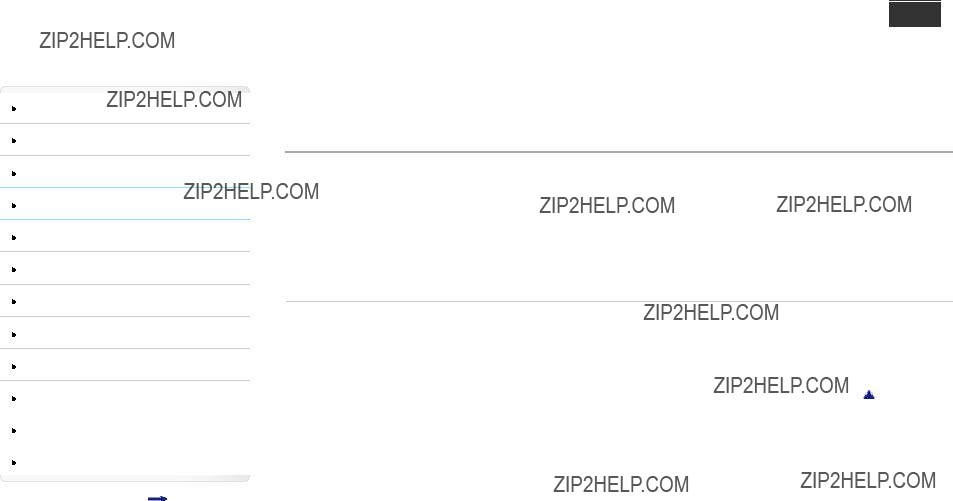
Search Print
Top page > Viewing > Deleting images > Deleting images
Deleting images
You can delete the currently displayed image.
You can also delete images from the MENU button. [Details]
1.Press the  (Playback) button to switch to playback mode.
(Playback) button to switch to playback mode.
2. /
/ (Delete) button
(Delete) button  [Delete]
[Delete] 
 on the control wheel
on the control wheel
Related Topic
Delete
70

Search Print
Top page > Viewing > Viewing movies > Viewing movies
Viewing movies
1.Press the  (Playback) button to switch to playback mode.
(Playback) button to switch to playback mode.
2.MENU 
 1
1  [Still/Movie Select]
[Still/Movie Select]  [Folder View(MP4)] or [AVCHD View].
[Folder View(MP4)] or [AVCHD View].
 To return to still image playback mode, select [Folder View(Still)].
To return to still image playback mode, select [Folder View(Still)].
3.Select a movie with the control wheel.
4.Press  .
.
Movie playback starts. When a movie file is played back to the end, the camera automatically starts playing back the next movie file.
On the movie viewing screen
The Playback bar appears, you can check a playback position of a movie.
 /
/ /
/ /
/ /
/ appears on the movie viewing screen.
appears on the movie viewing screen.
The icon displayed may vary depending on the record settings.
Turn the control wheel counterclockwise during pause. Rewind slow playback Movies are played back in frame advance.
Information display
71

Notes
 You may not be able to play back some images shot using other cameras.
You may not be able to play back some images shot using other cameras.
Related Topic
Still/Movie Select
 Back to top
Back to top
Copyright 2013 Sony Corporation
72

Search Print
Top page > Viewing > Viewing panoramic images > Scrolling panoramic images for display
Scrolling panoramic images for display
You can scroll panoramic images by pressing the center button on the control wheel while panoramic images are being displayed.
Press the  (Playback) button to display the whole image again.
(Playback) button to display the whole image again.
Control wheel Action
Starts scrolling playback/pauses scrolling playback
 Panoramic images recorded using another camera may not scroll correctly when played.
Panoramic images recorded using another camera may not scroll correctly when played.
 Back to top
Back to top
Copyright 2013 Sony Corporation
73

Top page > Useful shooting functions > Functions not available for each shooting mode > Functions not available for each shooting mode
Functions not available for each shooting mode
 Functions not available for each REC modes
Functions not available for each REC modes
 Functions not available for each [Scene Selection]
Functions not available for each [Scene Selection]
 Functions not available for each [Picture Effect]
Functions not available for each [Picture Effect]
In the table below, a check mark indicates a function that can be changed, while ??? indicates function that cannot be changed. The icons below [Flash Mode] and [Drive Mode] indicate the available modes.
When the shooting modes below are registered and recalled in  (Memory recall), the conditions for whether settings can be changed or not remain the same as in the table below.
(Memory recall), the conditions for whether settings can be changed or not remain the same as in the table below.
 Functions not available for each REC modes
Functions not available for each REC modes
 Functions not available for each [Scene Selection]
Functions not available for each [Scene Selection]

* Smile Shutter cannot be selected.
 Functions not available for each [Picture Effect]
Functions not available for each [Picture Effect]
* Smile Shutter cannot be selected.
Notes
75

 There may be some options that cannot be selected even in a function marked with
There may be some options that cannot be selected even in a function marked with  .
.  Available functions may be limited by other conditions.
Available functions may be limited by other conditions.
 Back to top
Back to top
Copyright 2013 Sony Corporation
76

Top page > Useful shooting functions > Functions not available for each shooting mode > MENU items not available for each shooting mode
MENU items not available for each shooting mode
 Still/Movie shooting menu items not available in some REC modes
Still/Movie shooting menu items not available in some REC modes
 Still/Movie shooting menu items not available for [Scene Selection] and [Picture Effect]
Still/Movie shooting menu items not available for [Scene Selection] and [Picture Effect]
In the table below, a check mark indicates settings that can be changed, while ??? indicates settings that cannot be changed. A setting may be fixed or restricted depending on the shooting mode.
 Still/Movie shooting menu items not available in some REC modes
Still/Movie shooting menu items not available in some REC modes

Still/Movie shooting menu items not available for [Scene Selection] and [Picture Effect]
The icons below  indicate the available modes.
indicate the available modes.

* Smile Shutter cannot be selected.
Notes
When the above shooting modes are registered and recalled in  (Memory recall), the conditions for whether settings can be changed or not remain the same as in the above table.
(Memory recall), the conditions for whether settings can be changed or not remain the same as in the above table.
 There may be some options that cannot be selected even in a function marked with
There may be some options that cannot be selected even in a function marked with  .
.  Available functions may be limited by other conditions.
Available functions may be limited by other conditions.
 Back to top
Back to top
Copyright 2013 Sony Corporation
79

Top page > Useful shooting functions > Using shooting functions > Tracking focus
Tracking focus
The camera tracks the subject and adjusts the focus automatically even when the subject is moving.
1.Press  on the control wheel. The target frame appears.
on the control wheel. The target frame appears.
2.Place the target frame over the subject you want to focus on, and press  . Tracking begins.
. Tracking begins.
3.Press the shutter button to shoot the image.
4.To cancel tracking focus before shooting, press  again.
again.
Tracking a face
If you use the tracking focus function while the Face Detection function is activated, you can select a face to be given priority and register that face with the camera. Even if the registered face disappears from the screen, when it shows up on the screen again, the camera focuses on the registered face.
When a specified face is registered in the camera???s memory and you use the Smile Shutter function, the camera searches only for that face???s smile.
When tracking a face, the subject???s body will be tracked when the subject???s face does not appear on the screen. You can set whether to give priority to a tracked face using [Face Priority Tracking]. [Details]
Notes
Tracking focus is not available in the following situations: When using zoom functions other than optical zoom When [Focus Mode] is set to [Manual Focus]
When [Autofocus Area] is set to [Flexible Spot]
Tracking focus will automatically be canceled when the subject disappears from the screen or has failed to be tracked. However, if the target of the tracking focus is a specified face, the camera keeps tracking on that face even if the face disappears from the screen.
Related Topic
Smile/Face Detect.
Face Priority Tracking
Functions not available for each shooting mode
 Back to top
Back to top
Copyright 2013 Sony Corporation
80
81

Search Print
Top page > Useful shooting functions > Using shooting functions > DISP (Display Contents)
DISP (Display Contents)
 Displaying histogram
Displaying histogram
1.Press  (Display Contents) on the control wheel, then select a desired mode.
(Display Contents) on the control wheel, then select a desired mode.
 Selectable modes can be set using MENU
Selectable modes can be set using MENU 
 1
1  [DISP Button].
[DISP Button].
In shooting mode
Shows basic shooting information.
Graphically shows the shutter speed and aperture value.
Graphic
Display
Shows recording information.
Display
All Info.
Does not show recording information.
No Disp.
Info.
Displays an indicator guide showing the angle of inclination of the camera to backward, forward, left or right. When the camera is held on a level, this indicator guide appears green.
Level
Displays the luminance distribution graphically (histogram). This mode can be set by selecting MENU 
 1
1  [DISP Button]
[DISP Button]  [Histogram].
[Histogram].
82

Histogram
In playback mode
Shows recording information.
Display Info.
Displays the histogram and recording information.
Histogram
Does not show recording information.
No Disp. Info.
Graphic display
The graphic display shows the shutter speed and the aperture value graphically in the picture, so that you can easily understand the exposure system. The shutter speed indicator bar and the aperture value indicator bar show the current values.
A: Shutter speed
B: Aperture value
83

 Displaying histogram
Displaying histogram
A histogram is a graph showing the brightness of an image. The graph display indicates a bright image when skewed to the right side (A), and a dark image when skewed to the left side (B).
1.Select MENU 
 1
1  [DISP Button].
[DISP Button].
2.Check [Histogram], then press MENU button.
3.Press  (Display Contents) repeatedly in shooting mode to display histogram.
(Display Contents) repeatedly in shooting mode to display histogram.
Notes
The histogram also appears when playing back a single image, but you cannot adjust the exposure. The histogram does not appear when:
Recording/playing back movies
Shooting in [Sweep Panorama] mode or viewing panoramic images
A large difference in the histogram displayed during shooting and playback may occur when: The flash strobes.
The shutter speed is slow or fast.
The histogram may not appear for images recorded using other cameras.
Related Topic
DISP Button
 Back to top
Back to top
Copyright 2013 Sony Corporation
84

Search Print
Top page > Useful shooting functions > Using shooting functions > Flash Mode
Flash Mode
You can also change [Flash Mode] using MENU.
1. Press  (Flash Mode) on the control wheel.
(Flash Mode) on the control wheel.
 When another function is assigned to the control wheel, press the MENU button
When another function is assigned to the control wheel, press the MENU button 
 2
2  [Flash Mode].
[Flash Mode].
2. Select the desired mode with the control wheel.
When ???White circular spots??? appear in flash photos
These spots are caused by particles (dust, pollen, etc.) floating close to the lens. When they are accentuated by the camera???s flash, they appear as white circular spots.
How can the ???White circular spots??? be reduced?
Light the room and shoot the subject without flash.
Select  (Anti Motion Blur) or
(Anti Motion Blur) or  (High Sensitivity) mode in [Scene Selection]. ([Flash Off] is automatically selected.)
(High Sensitivity) mode in [Scene Selection]. ([Flash Off] is automatically selected.)
Notes
The flash strobes twice. The first flash adjusts the light quantity.
While charging the flash,  flashes. After charging is completed, the flashing icon will light up. When using the flash, the flash pops up automatically. Do not cover the flash with your fingers. If not using the flash, press it down manually.
flashes. After charging is completed, the flashing icon will light up. When using the flash, the flash pops up automatically. Do not cover the flash with your fingers. If not using the flash, press it down manually.
You cannot use the flash when [Drive Mode] is set to
When shooting with the flash and the zoom is set to W, the shadow of the lens may appear on the screen, depending on the shooting conditions. If this happens, shoot away from the subject or set the zoom to T and shoot with the flash again.
85

Related Topic
Functions not available for each shooting mode
 Back to top
Back to top
Copyright 2013 Sony Corporation
86
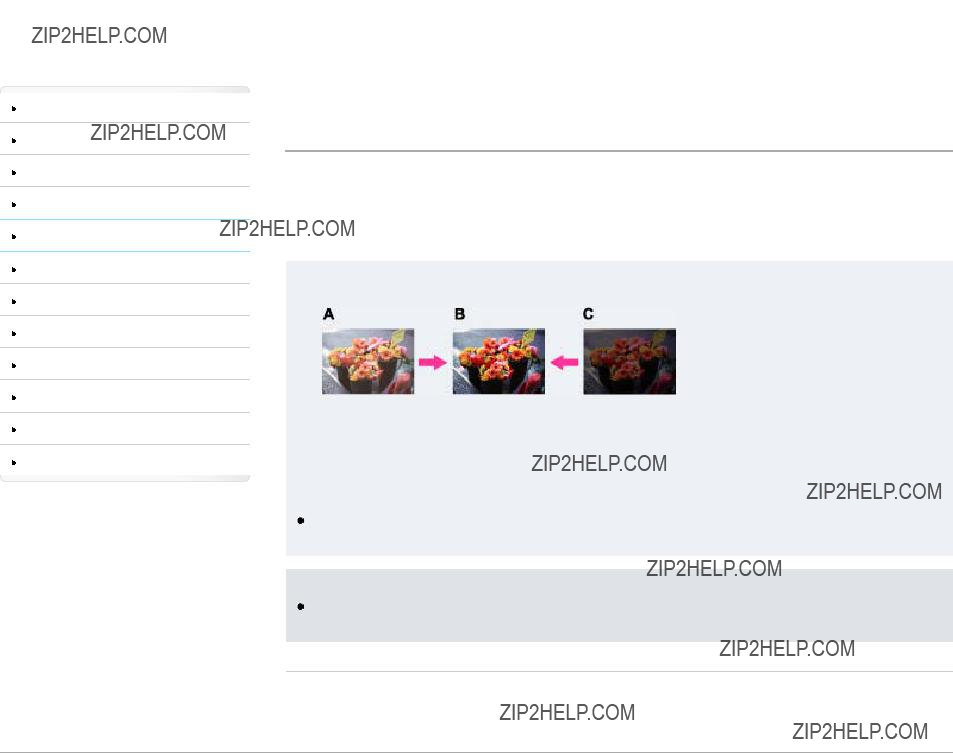
Top page > Useful shooting functions > Using shooting functions > Exposure Comp.
Exposure Comp.
You can adjust the exposure manually in 1/3 EV steps in a range of
1.Press the  /
/ (Exposure Comp.) on the control wheel.
(Exposure Comp.) on the control wheel.
2.Select the desired value using the control wheel.
 Adjusting the exposure for better looking images
Adjusting the exposure for better looking images
A: Overexposure (too much light)
B: Correct exposure
C: Underexposure (too little light)
When the image shot is overexposed, adjust [Exposure Comp.] to the minus side.  When the image shot is underexposed, adjust [Exposure Comp.] to the plus side.
When the image shot is underexposed, adjust [Exposure Comp.] to the plus side.
Notes
If you shoot a subject in extremely bright or dark conditions, or when you use the flash, the exposure adjustment may not be effective.
Related Topic
Functions not available for each shooting mode
 Back to top
Back to top
Copyright 2013 Sony Corporation
87

Top page > Useful shooting functions > Using shooting functions > Photo Creativity
Photo Creativity
[Photo Creativity] is a mode that allows you to operate the camera intuitively, using unusual screen display.
When the shooting mode is set to  (Intelligent Auto) or
(Intelligent Auto) or  (Superior Auto), you can change the settings easily and shoot images.
(Superior Auto), you can change the settings easily and shoot images.
1.Set the mode dial to  (Intelligent Auto) or
(Intelligent Auto) or  (Superior Auto).
(Superior Auto).
2.Press  /
/ (Photo Creativity) on the control wheel.
(Photo Creativity) on the control wheel.
3.Select the desired item with the control wheel.
4. Change the settings with the control wheel.
You can combine some settings by repeating steps 3 and 4.
To reset the changed settings to the default settings, press the  /
/
 (Brightness),
(Brightness),  (Color) and
(Color) and  (Vividness) are set to [AUTO], and
(Vividness) are set to [AUTO], and 
(Picture Effect) is set to  .
.
5.When shooting still images: Shoot with the shutter button.
When recording movies: Press the MOVIE (Movie) button to start recording.
Notes
When you record movies in [Photo Creativity] mode, you can only select [Bkground Defocus] while recording.
If you switch the camera mode to [Intelligent Auto] mode, [Superior Auto] mode or turn off the camera, the settings you changed revert to the default settings.
 When you set [Photo Creativity] in [Superior Auto] mode, overlaying images are disabled.
When you set [Photo Creativity] in [Superior Auto] mode, overlaying images are disabled.
Related Topic
Picture Effect
Functions not available for each shooting mode
 Back to top
Back to top
Copyright 2013 Sony Corporation
88

Search Print
Top page > Useful shooting functions > Using shooting functions > Drive Mode
Drive Mode
 Automatic shooting with
Automatic shooting with
You can set a drive mode, such as continuous,
Tips for preventing blur
If your hands or body move while holding the camera and pressing the shutter button, ???Camera shake??? occurs.
Camera shake occurs frequently under  (Night Portrait) or
(Night Portrait) or  (Night Scene) mode.
(Night Scene) mode.
89

To reduce camera shake, set the
Notes
When [Drive Mode] is set to  When the battery level is low, or a memory card is full, the burst stops.
When the battery level is low, or a memory card is full, the burst stops.
 Automatic shooting with
Automatic shooting with
Point the lens at yourself so that the selected number of faces is reflected in the screen. The shutter operates automatically. Do not move your camera after the beep sounds.
 You can also shoot an image by pressing the shutter button during this operation.
You can also shoot an image by pressing the shutter button during this operation.
Related Topic
Functions not available for each shooting mode
 Back to top
Back to top
Copyright 2013 Sony Corporation
90

Search Print
Top page > Useful shooting functions > Using shooting functions > Image Size
Image Size
[Image Size] determines the size of the image file that is recorded when you take an image.
The larger the image size, the more detail will be reproduced when the image is printed on
1. MENU 
 1
1  [Image Size]
[Image Size]  desired size
desired size
When [Aspect Ratio] is set to [3:2]
When [Aspect Ratio] is set to [16:9]
When [Aspect Ratio] is set to [4:3]
When [Aspect Ratio] is set to [1:1]
Notes
91

 When [Quality] is set to [RAW] or [RAW & JPEG], the RAW image size corresponds to L.
When [Quality] is set to [RAW] or [RAW & JPEG], the RAW image size corresponds to L.
Related Topic
Aspect Ratio
 Back to top
Back to top
Copyright 2013 Sony Corporation
92

93

Top page > Useful shooting functions > Using shooting functions > Quality
Quality
Selects the image quality for still images.
RAW images
You need the ???Image Data Converter??? software in order to open a RAW image recorded on this camera. With this software, a RAW image can be opened and converted to a common format, such as JPEG or TIFF, and its white balance, color saturation, contrast, etc., can be readjusted.
Notes
You cannot add DPOF (print order) registration to RAW format images.
You cannot use the following functions when [Quality] is set to [RAW] or [RAW & JPEG]. Zoom functions other than optical zoom
[Auto HDR] [Picture Effect]
[Auto Object Framing]
Related Topic
MENU items not available for each shooting mode ???Image Data Converter???
 Back to top
Back to top
Copyright 2013 Sony Corporation
94

95

Search Print
Top page > Useful shooting functions > Using shooting functions > Focus Mode
Focus Mode
Selects the focus method to suit the movement of the subject.
AF stands for ???Auto Focus,??? a function that adjusts the focus automatically.
 Using [DMF]/[Manual Focus]
Using [DMF]/[Manual Focus]
1.MENU 
 2
2  [Focus Mode]
[Focus Mode]  [DMF] or [Manual Focus]
[DMF] or [Manual Focus]
2.Adjust the focus by turning the Control Ring.
Use the peaking function, [Focus Magnifier] or [MF Assist] to adjust focus more easily. When [Focus Mode] is set to [DMF], auto focus activates when you press the shutter button halfway down.
Focusing using the [DMF] setting
Using [DMF] allows you to use a combination of manual and automatic focus adjustment as follows. After focusing automatically, make fine focus adjustments manually.
Effective when you want to focus narrowly. Hold down the shutter button halfway, then turn the Control Ring.
Adjust the focus manually in advance, then use automatic focus.
Effective for focusing on subjects that are toward the back of a scene because those subjects tend to be out of focus when using the automatic focus adjustment.
Notes
If the focus distance is set very close, the image may show dust or fingerprints on the lens. Wipe the lens with a soft cloth, etc.
 Once you change the focus method, the distance of the focus you set up is cleared.
Once you change the focus method, the distance of the focus you set up is cleared.
Related Topic
MENU items not available for each shooting mode
Peaking Level
Func. of Center Button
MF Assist
97

 Back to top
Back to top
Copyright 2013 Sony Corporation
98

Search Print
Top page > Useful shooting functions > Using shooting functions > Autofocus Area
Autofocus Area
 Using Flexible Spot
Using Flexible Spot
You can change the focusing area. Use the menu when it is difficult to get the proper focus in auto focus
Allows you to move the AF range finder frame to the desired point on the screen and focus on an extremely small subject in a narrow area.
(Flexible
Spot)
Notes
When you use the following functions, the AF range finder frame is disabled and appears in a dotted line. In this case, the camera works to focus on the subjects at the center of the screen.
Zoom functions other than optical zoom [AF Illuminator]
If the tracking focus is activated, the camera focuses with priority on the subject to be tracked.
 Using Flexible Spot
Using Flexible Spot
[Flexible Spot] is useful when you shoot a subject that is not in the center of the frame. You can shoot the subject without changing the composition.
99

A:AF range finder frame (yellow: adjustable/gray: fixed)
1.Use the control wheel to adjust the position of the AF range finder frame where you want to focus,
then press  .
.
To reset the setting, press  again.
again.
Related Topic
MENU items not available for each shooting mode
Tracking focus
 Back to top
Back to top
Copyright 2013 Sony Corporation
100
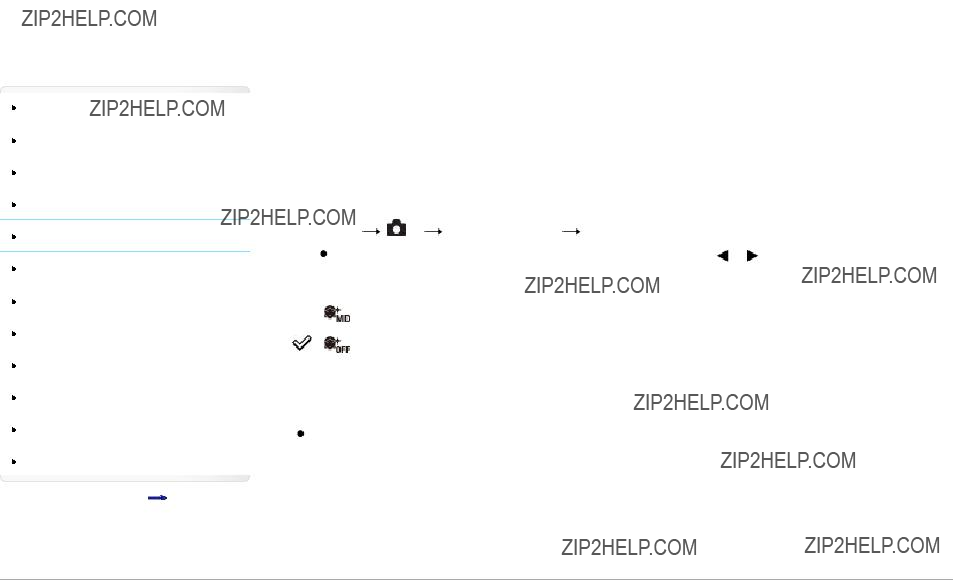
 Back to top
Back to top
Copyright 2013 Sony Corporation
101
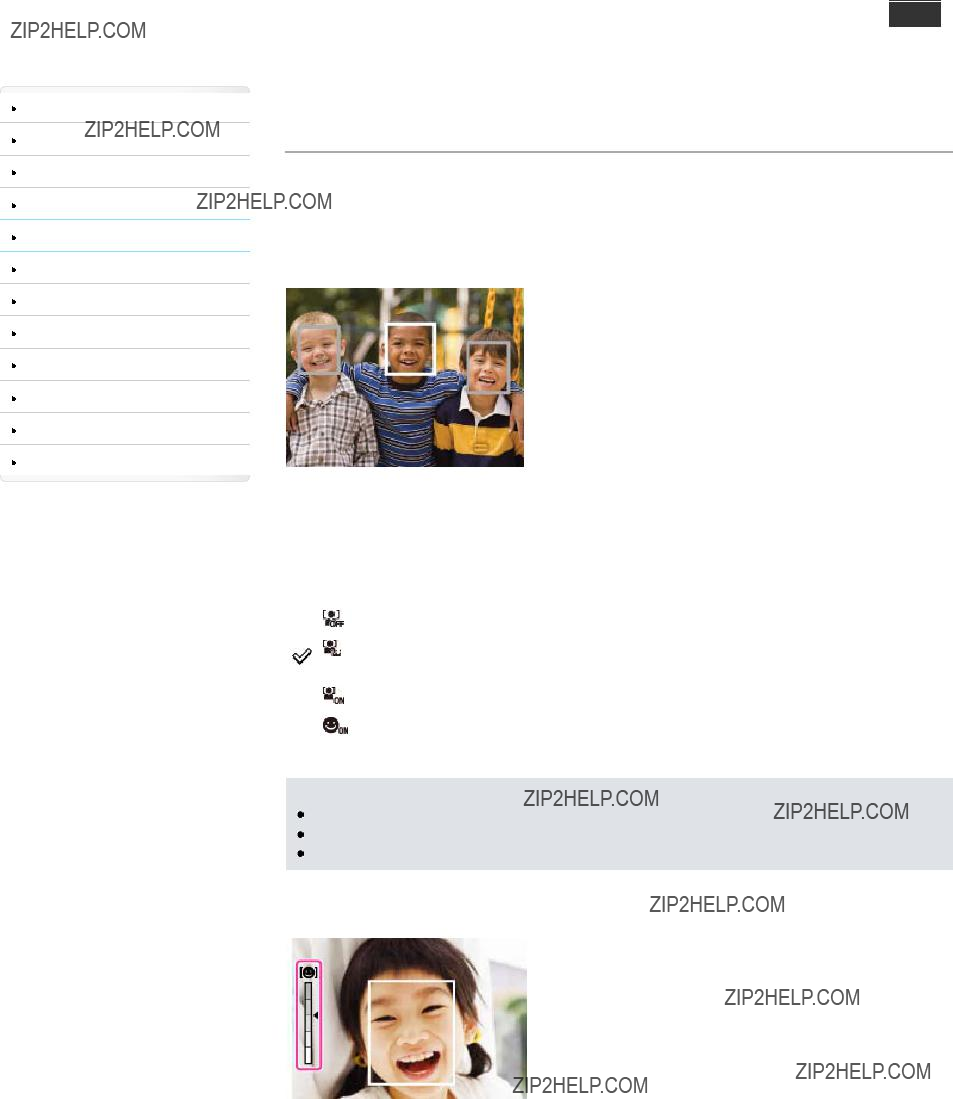
Search Print
Top page > Useful shooting functions > Using shooting functions > Smile/Face Detect.
Smile/Face Detect.
 Using Smile Shutter
Using Smile Shutter
When the Face Detection function is used, the camera detects the faces of your subjects and adjusts [Autofocus Area], [Flash Mode], [Exposure Comp.], [White Balance] and [Red Eye Reduction] settings automatically. When using [Smile Shutter], the camera detects smiles and releases the shutter automatically.
When the camera detects more than one subject, the camera will judge which is the main subject and set focus by priority. The frame for which the focus is set will turn green by pressing the shutter button halfway down.
1. MENU 
 2
2  [Smile/Face Detect.]
[Smile/Face Detect.]  desired mode
desired mode
Notes
[Off] is not available when [Drive Mode] is set to
The Face Detection function does not work when you use zoom functions other than optical zoom. Up to eight faces of your subjects can be detected.
 Using Smile Shutter
Using Smile Shutter
102

1.MENU 
 2
2  [Smile/Face Detect.]
[Smile/Face Detect.]  [Smile Shutter]
[Smile Shutter]
2.Press  /
/ on the control wheel to select a desired smile detection sensitivity.
on the control wheel to select a desired smile detection sensitivity.
 You can select the sensitivity to detect a smile from the following three levels;
You can select the sensitivity to detect a smile from the following three levels;  (On: Slight Smile),
(On: Slight Smile),  (On: Normal Smile) or
(On: Normal Smile) or  (On: Big Smile).
(On: Big Smile).
3.Wait for a smile to be detected.
When a face is detected and the smile level exceeds the  point on the indicator, the camera records images automatically.
point on the indicator, the camera records images automatically.
If you press the shutter button during Smile Shutter shooting, the camera shoots the image, then returns to Smile Shutter mode.
 Tips for better capturing of smiles
Tips for better capturing of smiles
Do not cover the eyes with bangs. Do not obscure the face by a hat, mask, sunglasses, etc.
Try to orient the face in front of the camera and be as level as possible. Keep the eyes narrowed.
Give a clear smile with an open mouth. The smile is easier to be detected when the teeth are showing.
The shutter operates when any person whose face is being detected smiles.
You can select or register a priority subject for face detection. When the selected face is registered in the camera memory, Smile Detection is performed only for that face.
 If a smile is not detected, set the smile detection sensitivity to [On: Slight Smile].
If a smile is not detected, set the smile detection sensitivity to [On: Slight Smile].
Notes
 Smiles may not be detected correctly depending on the conditions.
Smiles may not be detected correctly depending on the conditions.
Related Topic
Tracking focus
Face Registration
Functions not available for each shooting mode
MENU items not available for each shooting mode
 Back to top
Back to top
Copyright 2013 Sony Corporation
103

Top page > Useful shooting functions > Using shooting functions > Auto Object Framing
Auto Object Framing
When the camera detects and shoots faces,
Both the original and trimmed images are recorded. The trimmed image is recorded in the same size as the original image.
1.MENU 
 2
2  [Auto Object Framing]
[Auto Object Framing]  desired mode
desired mode
The  icon on the screen turns green when the camera decides that an image being captured can be trimmed.
icon on the screen turns green when the camera decides that an image being captured can be trimmed.
 After shooting, the trimmed area is indicated by a frame on the auto review screen.
After shooting, the trimmed area is indicated by a frame on the auto review screen.
(Off)
Sets whether or not to use [Auto Object Framing].
 (Auto)
(Auto)
Notes
The image may not be trimmed into its optimal composition depending on the shooting conditions. Auto Object Framing cannot be used in the following settings.
When [Quality] is set to [RAW] or [RAW & JPEG] When [DRO/Auto HDR] is set to [Auto HDR] When [Focus Mode] is set to [Manual Focus]
When [Drive Mode] is set to [Cont. Shooting], [Spd Priority Cont.],
When [ISO] is set to [Multi Frame Noise Reduct.]
 When [Smile/Face Detect.] is set to [Off], you cannot use [Auto Object Framing] for faces.
When [Smile/Face Detect.] is set to [Off], you cannot use [Auto Object Framing] for faces.
Related Topic
MENU items not available for each shooting mode
 Back to top
Back to top
Copyright 2013 Sony Corporation
104

Search Print
Top page > Useful shooting functions > Using shooting functions > ISO
ISO
1. MENU 
 3
3  [ISO]
[ISO]  desired mode
desired mode
 In case you select [Multi Frame Noise Reduct.] or [ISO AUTO], press
In case you select [Multi Frame Noise Reduct.] or [ISO AUTO], press  on the control wheel to display the setting screen, then select a desired value.
on the control wheel to display the setting screen, then select a desired value.
The camera sets the ISO sensitivity automatically based on the surrounding light
 (ISO AUTO)conditions. You can set the maximum and minimum ISO value for [ISO AUTO] mode.
(ISO AUTO)conditions. You can set the maximum and minimum ISO value for [ISO AUTO] mode.
Press  to display the setting screen.
to display the setting screen.
You can reduce image blurring in dark 100/125/160/200/400/800/1600/3200/6400/12800 locations or with moving subjects by increasing
the ISO sensitivity (select a larger number).
Adjusting ISO Sensitivity (Recommended Exposure Index)
ISO sensitivity is a speed rating for recording media that incorporates an image sensor that receives light. Even when the exposure is the same, images differ depending on the ISO sensitivity.
High ISO sensitivity
Records a bright image even in dark locations while increasing shutter speed to reduce blur. However, the image tends to be noisy.
Low ISO sensitivity
105

Records a smoother image.
However, when the exposure is insufficient, the image may be darker.
Notes
You cannot select [ISO AUTO] when the camera is set to [Manual Exposure]. [ISO 160] is the default setting.
When [ISO] is set to a value lower than ISO 160, the range for recordable subject brightness (dynamic range) may decrease.
For movies, the value between ISO 160 to ISO 3200 is available.
When [ISO] is set to [Multi Frame Noise Reduct.], the camera overlays the images. It takes more time to record an image, and the flash does not operate.
Related Topic
MENU items not available for each shooting mode
 Back to top
Back to top
Copyright 2013 Sony Corporation
106

Search Print
Top page > Useful shooting functions > Using shooting functions > Metering Mode
Metering Mode
Selects [Metering Mode] that sets which part of the subject to measure to determine the exposure. 1. MENU 
 3
3  [Metering Mode]
[Metering Mode]  desired mode
desired mode
Related Topic
MENU items not available for each shooting mode
 Back to top
Back to top
Copyright 2013 Sony Corporation
107

 Back to top
Back to top
Copyright 2013 Sony Corporation
108

Search Print
Top page > Useful shooting functions > Using shooting functions > White Balance
White Balance
 To capture a basic white color in [Custom Setup] mode
To capture a basic white color in [Custom Setup] mode
Adjusts color tones according to the surrounding light conditions. Use this function if image color appears unnatural.
In [White Balance] modes other than [C.Temp./Filter], you can fine tune the color tone as you like. Press  on the control wheel to display the adjustment screen, then adjust the tone using
on the control wheel to display the adjustment screen, then adjust the tone using
 Effects of lighting conditions
Effects of lighting conditions
The apparent color of the subject is affected by the lighting conditions.
The color tones are adjusted automatically, but you can adjust color tones manually using the White
109

Balance function.
Daylight (White as Standard)
Cloudy (Bluish)
Fluorescent
Incandescent (Reddish)
 To capture a basic white color in [Custom Setup] mode
To capture a basic white color in [Custom Setup] mode
1.MENU 
 3
3  [White Balance]
[White Balance]  [Custom Setup]
[Custom Setup]
2.Hold the camera so that the white area fully covers the AF area located in the center, and then press the shutter button down.
The shutter clicks and the calibrated values (Color Temperature and Color filter) are displayed.
3.Press  on the control wheel.
on the control wheel.
The screen returns to the recording information display while retaining the memorized custom white balance setting.
The custom white balance setting registered using this operation is effective until a new setting is registered.
Notes
The message ???Custom WB Error??? indicates that the value is beyond the expected range. (For example, when the flash is used on a subject in close proximity or when a brightly colored subject is
in the frame.) If you register this value, the  indicator turns yellow on the recording information display. You can shoot at this point, but it is recommended that you set the white balance again to obtain a more accurate white balance value.
indicator turns yellow on the recording information display. You can shoot at this point, but it is recommended that you set the white balance again to obtain a more accurate white balance value.
Do not shake or strike the camera while capturing the basic white color.
If the flash is used when the shutter button is pressed, a custom white balance is registered with the flash light taken into account. Take pictures with the flash in later shootings.
110

Related Topic
MENU items not available for each shooting mode
 Back to top
Back to top
Copyright 2013 Sony Corporation
111

Search Print
Top page > Useful shooting functions > Using shooting functions > DRO/Auto HDR
DRO/Auto HDR

 Auto HDR
Auto HDR
Corrects the brightness or contrast.
1. MENU 
 3
3  [DRO/Auto HDR]
[DRO/Auto HDR]  desired mode
desired mode
 By dividing the image into small areas, the camera analyzes the contrast of light and (D- shadow between the subject and the background, producing the image with the optimal
By dividing the image into small areas, the camera analyzes the contrast of light and (D- shadow between the subject and the background, producing the image with the optimal
Range brightness and gradation. Opt.)
Shoots three images with different exposures, and then overlays the bright area of the
under exposed image and the dark area of the over exposed image to create an image (Auto with rich gradation. One image with proper exposure and one overlaid image are
HDR) recorded.

1.MENU 
 3
3  [DRO/Auto HDR]
[DRO/Auto HDR] 
2.Select the optimal level using  /
/ on the control wheel.
on the control wheel.
* The Lv number that appears with the  mark indicates the current setting value.
mark indicates the current setting value.
Notes
When shooting with
 Auto HDR
Auto HDR
1.MENU 
 3
3  [DRO/Auto HDR]
[DRO/Auto HDR]  [Auto HDR]
[Auto HDR]
2.Select the optimal level using  /
/ on the control wheel.
on the control wheel.
 (Auto HDR:
(Auto HDR:
Exposure Diff. Corrects the exposure difference automatically.
Auto)
112

 (Exposure Difference Level)*
(Exposure Difference Level)*
Sets the exposure difference, based on the contrast of the subject. Select the optimal level between 1.0 EV (weak) and 6.0 EV (strong).
For example, if you set the exposure value to 2.0EV, three images will be composed;
* The EV number that appears with the  mark indicates the current setting value.
mark indicates the current setting value.
Notes
Since the shutter is released three times for one shot, be careful about the following: Use this function when the subject is motionless or does not blink
Do not recompose.
You cannot use this function with RAW images.
You cannot start the next shoot until the capture process is completed after you shoot.
You may not obtain a desired effect depending on the luminance difference of a subject and the shooting conditions.
When the flash is used, this function has little effect.
When the contrast of the scene is low or when significant camera shake or subject blur has occurred, you may not obtain good HDR images. If the camera detects such situation,  is indicated on the recorded image to inform you of this situation. Shoot again, as necessary, recomposing or paying attention to the blur.
is indicated on the recorded image to inform you of this situation. Shoot again, as necessary, recomposing or paying attention to the blur.
Related Topic
MENU items not available for each shooting mode
 Back to top
Back to top
Copyright 2013 Sony Corporation
113

Search Print
Top page > Useful shooting functions > Using shooting functions > Creative Style
Creative Style
Allows you to select the desired image processing.
You can adjust contrast, saturation and sharpness as you like for each [Creative Style] mode. Unlike with [Scene Selection], where images are shot automatically, you can adjust the exposure (shutter speed/aperture value), etc.
1. MENU 
 3
3  [Creative Style]
[Creative Style]  desired mode
desired mode
The saturation, contrast, and sharpness are heightened for shooting vivid and crisp (Landscape) scenery. Distant landscapes also stand out more.
&White) For shooting images in black and white monotone.
2.When you want to adjust  (Contrast),
(Contrast),  (Saturation), or
(Saturation), or  (Sharpness), press
(Sharpness), press  /
/ on the control wheel.
on the control wheel.
3.Select a desired value using  /
/ .(Black
.(Black
Notes
 When [Creative Style] is set to [Black & White], [Saturation] cannot be adjusted.
When [Creative Style] is set to [Black & White], [Saturation] cannot be adjusted.
Related Topic
MENU items not available for each shooting mode
 Back to top
Back to top
Copyright 2013 Sony Corporation
114

Search Print
Top page > Useful shooting functions > Using shooting functions > Picture Effect
Picture Effect
Select the desired effect filter to achieve a more impressive and artistic expression. 1. MENU 
 3
3  [Picture Effect]
[Picture Effect]  desired mode
desired mode
 If you select a mode with optional settings, select the desired setting using
If you select a mode with optional settings, select the desired setting using  /
/ on the
on the
control wheel.
 If you want to add effects to movies, press the MOVIE (Movie) button.
If you want to add effects to movies, press the MOVIE (Movie) button.
Allows you to shoot images with effects such as tunnel effect, high contrast, or color cast as if they were shot with a toy camera. You can set the color tone using  /
/ .
.
 (Toy
(Toy
Camera)
Allows you to shoot a pop
 (Pop
(Pop
Color)
Creates a high contrast, abstract look by heavily emphasizing primary colors, or in black and white.
You can select primary colors or black and white using  /
/ .
.
(Posterization)
Creates the look of an aged photo with sepia color tones and faded contrast.
 (Retro
(Retro
Photo)
Allows you to shoot soft, clear images with an emphasis on brightness.
115

 (Soft
(Soft
Allows you to shoot an image that makes a strong impression by leaving a specified color on portions of a monochrome image. You can select the color to be left using
 /
/ .
.
 (Partial
(Partial
Color)
Creates an intense,
 (High
(High
Contrast
Mono.)
Creates an image filled with a soft lighting effect.
You can set the intensity of the effect using  /
/ .
.
 (Soft
(Soft
Focus)
Allows you to shoot multiple images with different exposures to create a single image that looks like an oil painting. You can set the effect intensity using  /
/ .
.
 (HDR
(HDR
Painting)
Allows you to shoot multiple images with different exposures, to create a single monochrome image with rich gradation and detail.

Mono.)
Allows an image to be processed so that it looks as though you were shooting dioramas. One part of the image is blurred for a
the blurred part using  /
/ .
.
116

(Miniature)
Allows you to shoot an image with ink bleed and blurring effects as if it painted with watercolors.
(Watercolor)
Allows you to shoot an  /
/ .
.
(Illustration)
To add an effect to a movie
The following [Picture Effect] modes are effective for movies. The Dual Rec function cannot be used.
[Toy Camera]
[Pop Color] [Posterization] [Retro Photo] [Soft
[High Contrast Mono.]
Notes
The [Miniature] effect may not be applied when using a zoom function other than optical zoom. When using [Partial Color], the selected color may not remain depending on the subject or shooting condition.
In the following situations, you cannot confirm the effect before shooting. You also cannot set [Drive Mode].
[Soft Focus] [HDR Painting]
When the contrast of the scene is low or when significant camera shake or subject blur has occurred with [HDR Painting] or
If the camera detects such situations,  is indicated on the recorded image to inform you of this situation. Shoot again, as necessary, recomposing or paying attention to the blur.
is indicated on the recorded image to inform you of this situation. Shoot again, as necessary, recomposing or paying attention to the blur.
Related Topic
MENU items not available for each shooting mode
117

 Back to top
Back to top
Copyright 2013 Sony Corporation
118

Search Print
Top page > Useful shooting functions > Using shooting functions > Clear Image Zoom
Clear Image Zoom
 Total zoom scale when [Clear Image Zoom] is selected (including 3.6?? optical zoom)
Total zoom scale when [Clear Image Zoom] is selected (including 3.6?? optical zoom)
[Clear Image Zoom] allows you to enlarge the image with close to the original image quality when shooting still images.
The camera zooms images with the original image quality first depending on the selected image size. When [Clear Image Zoom] is set to [On], the camera automatically switches over to [Clear Image Zoom] when the zoom range without deterioration of the original image quality is exceeded.
1. MENU 
 4
4  [Clear Image Zoom]
[Clear Image Zoom]  desired mode
desired mode
Notes
To zoom images within the range where original image quality can be retained, set both [Clear Image Zoom] and [Digital Zoom] to [Off]. [Details]
The [Clear Image Zoom] function does not operate in the following situations: In movie mode
In [Sweep Panorama] mode
When the Smile Shutter function is activated.
When [Drive Mode] is set to [Cont. Shooting], [Spd Priority Cont.],
When [Quality] is set to [RAW] or [RAW & JPEG]. When [ISO] is set to [Multi Frame Noise Reduct.].
When [Drive Mode] is set to [Cont. Shooting], [Spd Priority Cont.],
 The Face Detection function does not operate in the range of [Clear Image Zoom].
The Face Detection function does not operate in the range of [Clear Image Zoom].
Total zoom scale when [Clear Image Zoom] is selected (including 3.6?? optical zoom)
The supported zoom scales are different depending on the image size.
When [Aspect Ratio] is set to [3:2]
Image size Total zoom scale
L:20M Approx. 7.2??
M:10M Approx. 10??
 Back to top
Back to top
119
Copyright 2013 Sony Corporation
120

When the Smile Shutter function is activated.
When [Drive Mode] is set to
When [Quality] is set to [RAW] or [RAW & JPEG].
When [ISO] is set to [Multi Frame Noise Reduct.].
The Face Detection function does not operate in the range of [Digital Zoom].
 Back to top
Back to top
Copyright 2013 Sony Corporation
121

Top page > Useful shooting functions > Using shooting functions > Long Exposure NR
Long Exposure NR
When you set the shutter speed to 1/3 second or longer (Long exposure shooting), noise reduction is turned on for the same duration that the shutter is open. This is to reduce the grainy noise typical in a long exposure.
1. MENU 
 4
4  [Long Exposure NR]
[Long Exposure NR]  desired mode
desired mode
Notes
Even when [Long Exposure NR] is set to [On], noise reduction is not available in the following situations:
When [Drive Mode] is set to [Cont. Shooting], [Spd Priority Cont.],
 When [Scene Selection] is set to
When [Scene Selection] is set to  (Sports Action) or
(Sports Action) or 
 In [Sweep Panorama] mode
In [Sweep Panorama] mode
Related Topic
MENU items not available for each shooting mode
 Back to top
Back to top
Copyright 2013 Sony Corporation
122
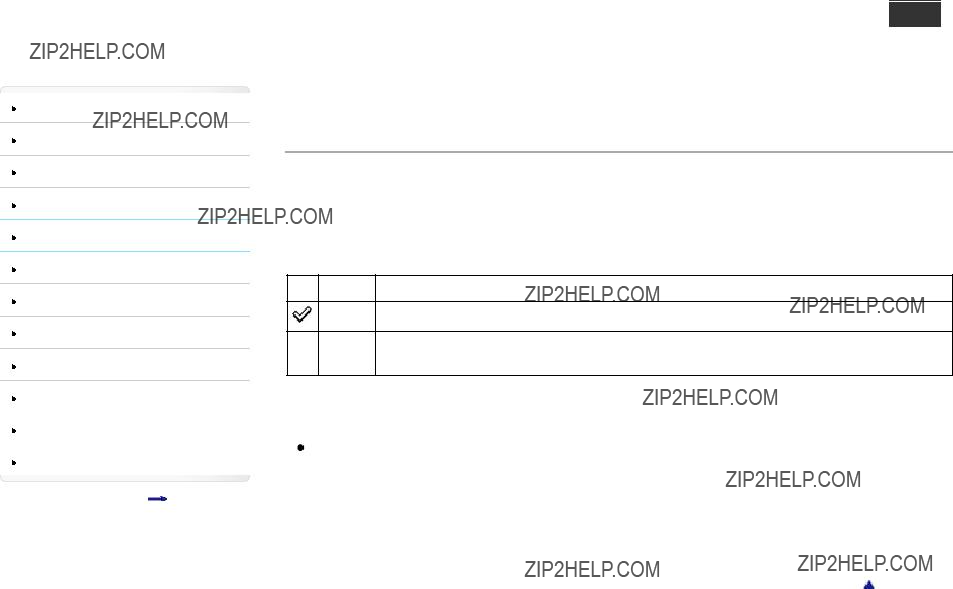
Search Print
Top page > Useful shooting functions > Using shooting functions > High ISO NR
High ISO NR
When shooting with a high ISO, the camera reduces noise. When noise reduction is in progress, in some cases a message may appear, and you cannot take another picture during that time.
1. MENU 
 4
4  [High ISO NR]
[High ISO NR]  desired mode
desired mode
Normal Activates high ISO noise reduction normally.
123

Top page > Useful shooting functions > Using shooting functions > AF Illuminator
AF Illuminator
The AF illuminator supplies fill light to focus more easily on a subject in dark surroundings.
The AF illuminator emits red light allowing the camera to focus easily when the shutter button is pressed halfway, until the focus is locked.
The  indicator appears at this time.
indicator appears at this time.
1. MENU 
 4
4  [AF Illuminator]
[AF Illuminator]  desired mode
desired mode
Auto
Off
Sets whether or not to use the AF illuminator.
selected in [Scene Selection].
When you use the AF illuminator, the normal AF range finder frame is disabled and a new AF range finder frame is displayed by a dotted line. AF operates with priority on subjects located near the center of the frame.
The AF illuminator emits very bright light. Although there is no health hazard, do not look directly into the AF illuminator emitter at close range.
 Back to top
Back to top
Copyright 2013 Sony Corporation
124

Copyright 2013 Sony Corporation
125

 Back to top
Back to top
Copyright 2013 Sony Corporation
126
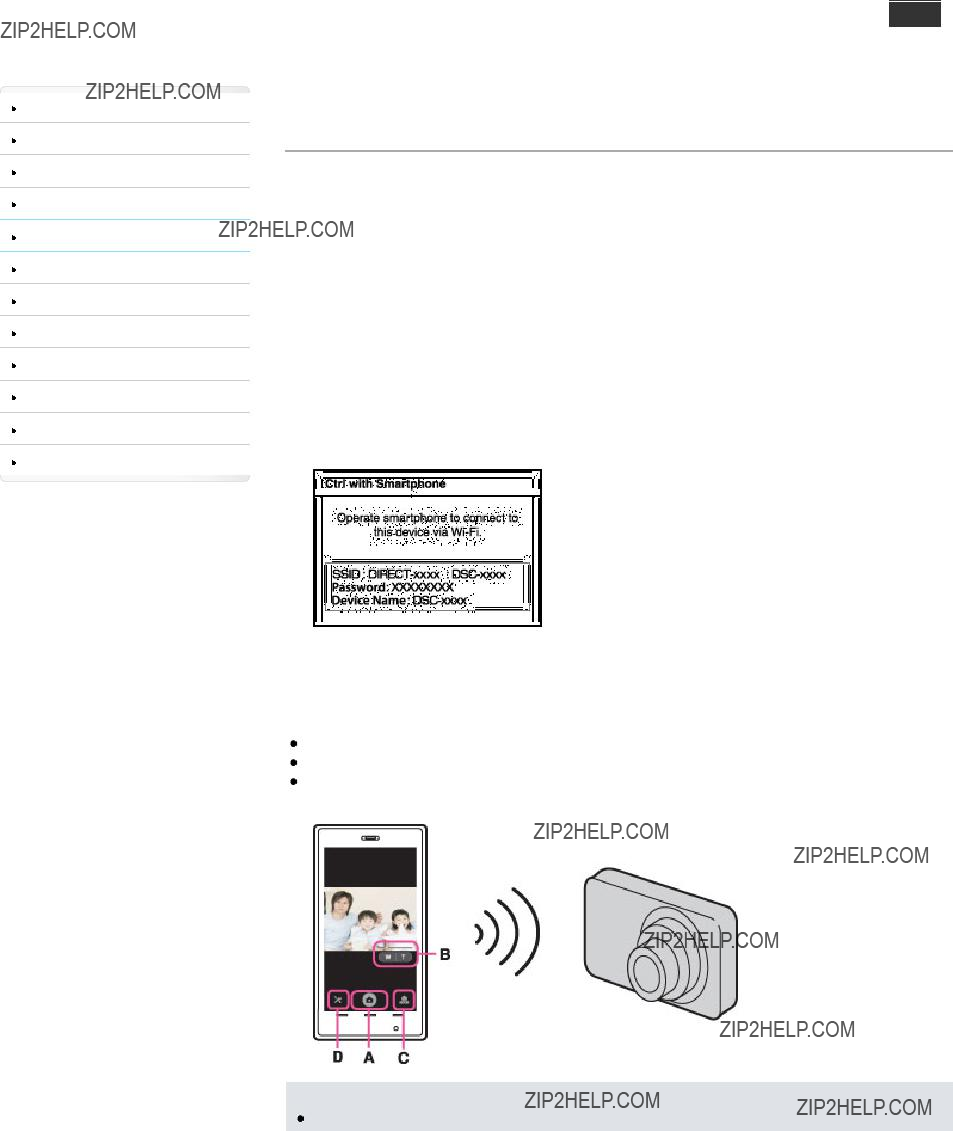
Search Print
Top page > Useful shooting functions > Using shooting functions > Ctrl with Smartphone
Ctrl with Smartphone
 Connect to the camera from an Android smartphone
Connect to the camera from an Android smartphone
 Connect to the camera from an iOS smartphone
Connect to the camera from an iOS smartphone
 Connect the camera to an Android smartphone with one touch
Connect the camera to an Android smartphone with one touch
 Functions that can be set with the smartphone
Functions that can be set with the smartphone
You can shoot still images and movies by controlling the camera remotely by a smartphone.
You can also save recorded still images on your smartphone. Install the smartphone support application ???PlayMemories Mobile??? to your smartphone from the application store. If ???PlayMemories Mobile??? has already been installed on your smartphone, update it to the latest version.
For details on ???PlayMemories Mobile???, refer to the support website (http://www.sony.net/pmm/).
1.MENU 
 1
1  [Ctrl with Smartphone]
[Ctrl with Smartphone]
2.Connect to the camera from your smartphone, using the information that appears on the screen when the camera is ready to be connected. Connection methods differ, depending on the type of smartphone. [Details] [Details]
 If you assign [Ctrl with Smartphone] to
If you assign [Ctrl with Smartphone] to  /
/ on the control wheel, you can display the smartphone control screen immediately by pressing
on the control wheel, you can display the smartphone control screen immediately by pressing  /
/ .
.
3. Determine the composition on the screen of the smartphone, then press the shutter button (A) to shoot.
You can zoom with the zoom button (B).
You can switch between still images and movies (C).
You can configure settings for [Flash],
Notes
When the image size is not [VGA], still images recorded on a smartphone are in [2M] format.
127

 Movies cannot be recorded on a smartphone.
Movies cannot be recorded on a smartphone.
 Connect to the camera from an Android smartphone
Connect to the camera from an Android smartphone
1.Start ???PlayMemories Mobile??? on your smartphone.
2.Select
3. Input the password displayed on the camera.
The smartphone is connected to the camera.
 Connect to the camera from an iOS smartphone
Connect to the camera from an iOS smartphone
1. Select
2. Input the password displayed on the camera.
128

The smartphone is connected to the camera.
3. Start ???PlayMemories Mobile??? on your smartphone.
Connect the camera to an Android smartphone with one touch (One- touch remote (NFC))
You can connect the camera to an NFC smartphone with just one touch, without the need for complicated settings.
1.Activate the NFC functions of smartphone.
2.Set the camera to shooting mode.
 You can use the NFC function only when
You can use the NFC function only when  (N Mark) is displayed on the screen.
(N Mark) is displayed on the screen.
3.Touch the camera to the smartphone.
The smartphone is connected to the camera, and ???PlayMemories Mobile??? is activated. The smartphone control screen is displayed.
Continue touching until ???PlayMemories Mobile??? starts (1 - 2 seconds).
Touch the N mark of the smartphone to  (N Mark) of the camera. If there is no N mark on the smartphone, refer to the manual of the smartphone.
(N Mark) of the camera. If there is no N mark on the smartphone, refer to the manual of the smartphone.
About NFC
NFC (Near Field Communication) is a technology enabling
NFC (Near Field Communication) is an international standard of the
129

Notes
If you cannot connect the smartphone and camera correctly, do the following.
 Activate ???PlayMemories Mobile??? on the smartphone, then move the smartphone slowly around
Activate ???PlayMemories Mobile??? on the smartphone, then move the smartphone slowly around  (N mark) of the camera.
(N mark) of the camera.
If you have put a case on your smartphone, remove the case. If you have put a case on the camera, remove the case.
If you have attached a tripod to the camera, remove the tripod temporarily. Confirm that the NFC functions are activated on the smartphone.
When the camera is in Airplane mode, connection to a smartphone is not possible. Set [Airplane Mode] to [Off].
If you connect the camera to a smartphone via NFC while the playback screen is displayed on the camera, the image being played back will be transferred to the smartphone.
 Functions that can be set with the smartphone
Functions that can be set with the smartphone
130

Search Print
Top page > Useful shooting functions > Using shooting functions > Write Date
Write Date
Sets whether to record a shooting date on the still image.
Notes
You cannot record dates in the following situations: In movie mode
When shooting still images while recording a movie (Dual Rec) In [Sweep Panorama] mode
In burst or bracket shooting mode [Quality] is set to [RAW] or [RAW & JPEG]
If you shoot images with the date once, you cannot delete the date from the images later. The dates are doubly printed, if you set the camera to superimpose the dates when printing. The recorded time of the image cannot be superimposed on the image.
 Back to top
Back to top
Copyright 2013 Sony Corporation
131

Search Print
Top page > Useful shooting functions > Using shooting functions > Memory
Memory
 Items that can be registered
Items that can be registered
 To recall registered settings
To recall registered settings
Allows you to register up to three
1.Set the camera to the setting you want to register.
2.MENU 
 5
5  [Memory]
[Memory]  desired number
desired number
Notes
 When correcting settings, follow steps 1 ??? 2 again.
When correcting settings, follow steps 1 ??? 2 again.
 Items that can be registered
Items that can be registered
Available shooting settings are as follows: Shooting modes set using the mode dial Aperture (F value)
Shutter speed
EV
(Still shooting menu) items
(Movie shooting menu) items Optical zoom scale
Notes
 Program shift and Manual Focus cannot be registered.
Program shift and Manual Focus cannot be registered.
 To recall registered settings
To recall registered settings
1.Set the mode dial to  (Memory recall).
(Memory recall).
2.Press  /
/ on the control wheel or turn the control wheel to select the desired number
on the control wheel or turn the control wheel to select the desired number
Notes
If you set  (Memory recall) after completing the shooting settings, the recalled [Memory] values are given priority and the original settings may become invalid. Check the indicators on the screen before shooting.
(Memory recall) after completing the shooting settings, the recalled [Memory] values are given priority and the original settings may become invalid. Check the indicators on the screen before shooting.
Related Topic
Memory recall
MENU items not available for each shooting mode
 Back to top
Back to top
Copyright 2013 Sony Corporation
132

Search Print
Top page > Useful shooting functions > Using shooting functions > Record Setting
Record Setting
The larger the size of the movie image, the higher the image quality. The higher the amount of data used per second (average
1. MENU 
 1
1  [Record Setting]
[Record Setting]  desired mode
desired mode
File Format: AVCHD
60i/50i:
Movies are recorded at approximately 60 fields/sec (for 1080
24p/25p:
Movies are recorded at approximately 24 frames/sec (for 1080
60p/50p:
Movies are recorded at approximately 60 frames/sec (for 1080
File Format: MP4
Movies shot are recorded in
Record Setting Average
134

Notes
A telephoto image is produced when [VGA 3M] image size is selected.
When you create AVCHD discs from movies recorded in [60p 28M(PS)]/[50p 28M(PS)], [60i 24M(FX)]/[50i 24M(FX)] or [24p 24M(FX)]/[25p 24M(FX)], it will take time, as the image quality must be converted. To save [60p 28M(PS)]/[50p 28M(PS)], [60i 24M(FX)]/[50i 24M(FX)] or [24p 24M(FX)]/[25p 24M(FX)] movies without converting the image quality, use
Related Topic
File Format
 Back to top
Back to top
Copyright 2013 Sony Corporation
135
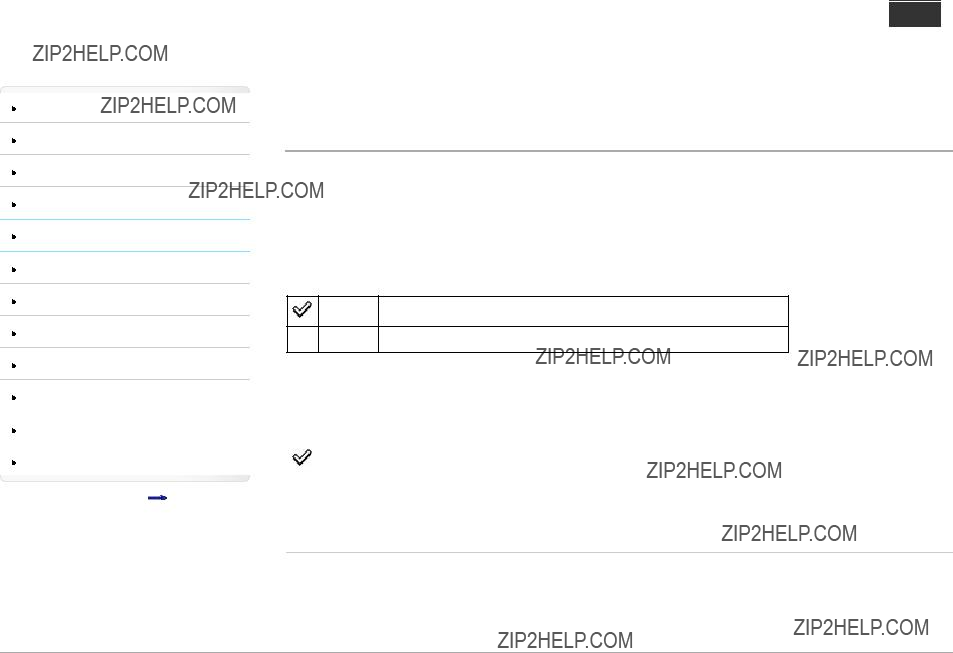
Search Print
Top page > Useful shooting functions > Using shooting functions > Image Size(Dual Rec)
Image Size(Dual Rec)
Sets the still image size shot while recording a movie.
1. MENU 
 1
1  [Image Size(Dual Rec)]
[Image Size(Dual Rec)]  desired size
desired size
When [Record Setting] is set to other than [VGA 3M]
L: 17M For viewing on a
S: 4.2M For viewing on a
Related Topic
MENU items not available for each shooting mode
 Back to top
Back to top
Copyright 2013 Sony Corporation
136

Top page > Useful shooting functions > Using shooting functions > SteadyShot
SteadyShot
The strength of [SteadyShot] effect when shooting movies can be adjusted.
1. MENU 
 1
1  [SteadyShot]
[SteadyShot]  desired mode
desired mode
137

138

140
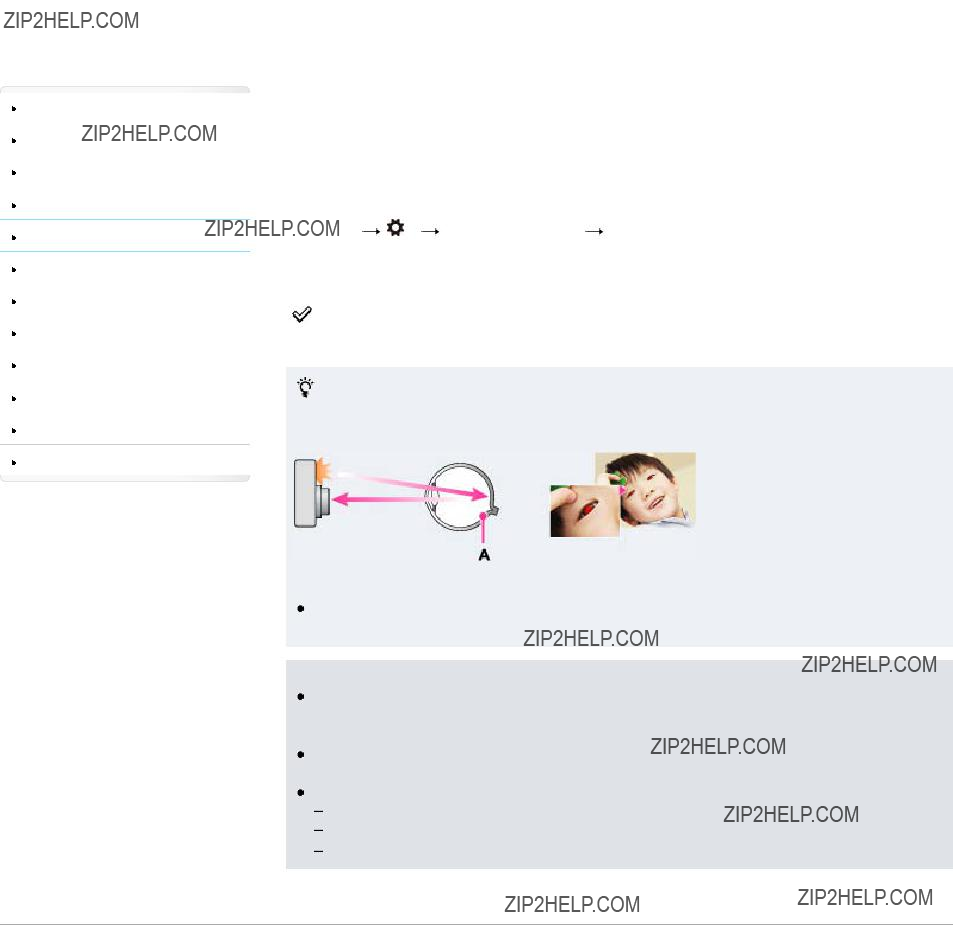
Precautions / About this camera
Other ways to reduce
Select  (High Sensitivity) mode in [Scene Selection]. ([Flash Mode] is set to [Flash Off] automatically.)
(High Sensitivity) mode in [Scene Selection]. ([Flash Mode] is set to [Flash Off] automatically.)
Notes
To avoid blurring of images, hold the camera firmly until the shutter is released. It usually takes a second until the shutter is released, and also be sure not to allow the subject to move during this period.
[Red Eye Reduction] may not produce the desired effects. It depends on individual differences and conditions, such as the distance to the subject or if the subject looked away from the
In [Sweep Panorama] mode
When  (Night Scene) or
(Night Scene) or 
 Back to top
Back to top
Copyright 2013 Sony Corporation
141

142
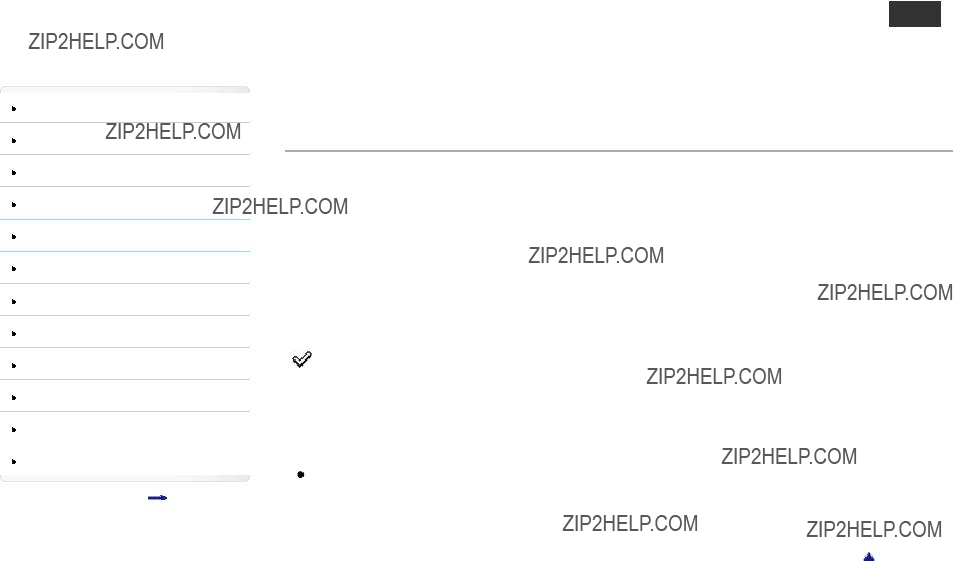
Search Print
Top page > Useful shooting functions > Using shooting functions > Auto Review
Auto Review
You can check the recorded image on the screen right after the shooting. You can change the displayed time.
1. MENU 
 1
1  [Auto Review]
[Auto Review]  desired mode
desired mode
143

Search Print
Top page > Useful shooting functions > Using shooting functions > DISP Button
DISP Button
When shooting, set available screen display mode by pressing the DISP (Display Contents) button on the control wheel.
1.MENU 
 1
1  [DISP Button]
[DISP Button]  desired mode The items marked with
desired mode The items marked with  are available.
are available.
2.Press the MENU button to set.
Shows basic shooting information. Graphically shows the shutter speed and aperture value.
Graphic
Display
Displays shooting information.
Display
All Info.
Does not display shooting information.
No Disp.
Info.
Displays an indicator guide showing the angle of inclination of the camera to backward, forward, left or right. When the camera is held on a level, this indicator guide appears green.
Level
Displays the luminance distribution graphically.
Histogram
144

Related Topic
DISP (Display Contents)
 Back to top
Back to top
Copyright 2013 Sony Corporation
145

Top page > Useful shooting functions > Using shooting functions > Peaking Level
Peaking Level
Enhances the outline of
1. MENU 
 1
1  [Peaking Level]
[Peaking Level]  desired mode
desired mode
Notes
Since the camera judges that sharp areas are in focus, the peaking level differs, depending on the subject, shooting situation.
 The outline of
The outline of
Related Topic
Peaking Color
 Back to top
Back to top
Copyright 2013 Sony Corporation
146
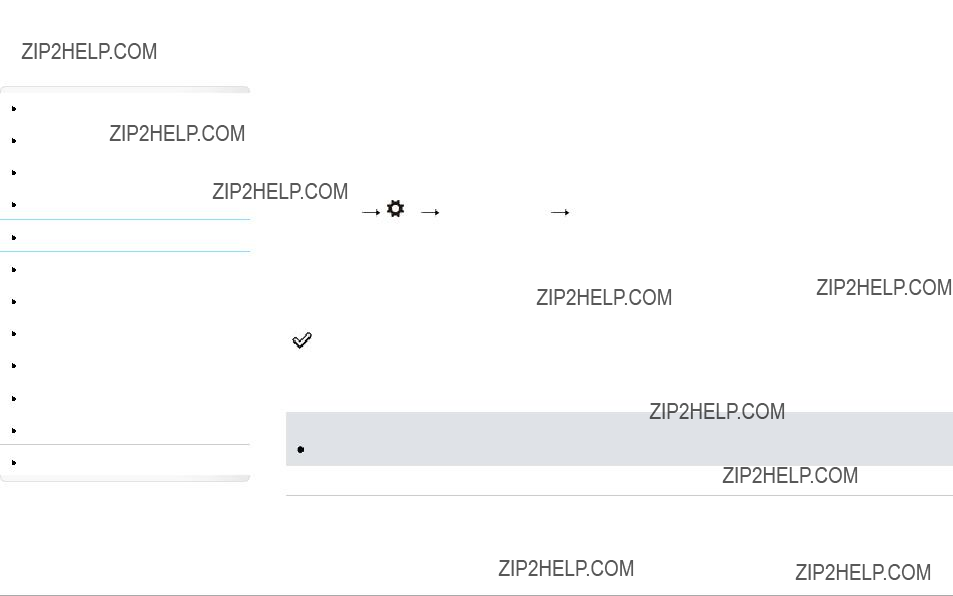
This item cannot be set when [Peaking Level] is set to [Off].
147

Search Print
Top page > Useful shooting functions > Using shooting functions > Control Ring
Control Ring
Notes
When [Focus Mode] is set to [DMF] or [Manual Focus], the function assigned to the Control Ring cannot be recalled. The Control Ring is used for manual focusing.
 Functions assigned when [Control Ring] is set to [Standard]
Functions assigned when [Control Ring] is set to [Standard]
Related Topic
How to use Control Ring
 Back to top
Back to top
Copyright 2013 Sony Corporation
148

Top page > Useful shooting functions > Using shooting functions > Zoom Func. on Ring
Zoom Func. on Ring
Sets the zooming method when the zoom function is assigned to the Control Ring.
In the default setting, the zoom function is assigned to the Control Ring when shooting mode is set to [Intelligent Auto] or [Superior Auto].
1. MENU 
 2
2  [Zoom Func. on Ring]
[Zoom Func. on Ring]  desired mode
desired mode
Standard Zooms in/out smoothly using the Control Ring.
Zooms in/out at fixed focal length steps, using the Control Ring. Step Fixed steps* are 28 mm, 35 mm, 50 mm, 70 mm and 100 mm.
* 35 mm equivalent
Notes
In the following cases, the zoom will be [Standard] even if [Step] is set.
When you zoom using the W/T (zoom) lever
While recording movies
While zoom functions other than optical are used
Related Topic
Control Ring
 Back to top
Back to top
Copyright 2013 Sony Corporation
149

Search Print
Top page > Useful shooting functions > Using shooting functions > Control Ring Display
Control Ring Display
Sets whether to display animation when operating the Control Ring. 1. MENU 
 2
2  [Control Ring Display]
[Control Ring Display]  desired mode
desired mode
On Sets whether to display animation.
Off
150
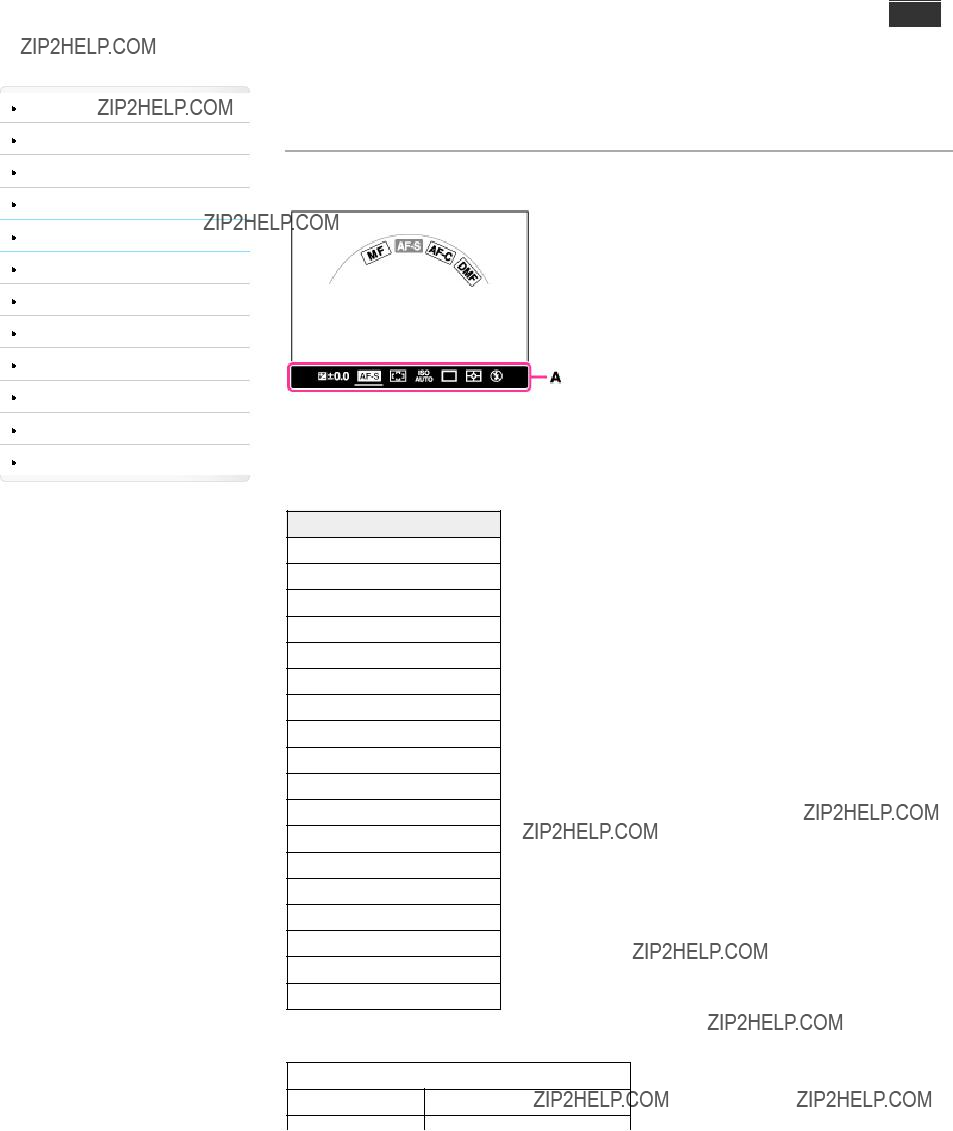
Search Print
Top page > Useful shooting functions > Using shooting functions > Function Button
Function Button
You can customize the seven functions (A) assigned to the Fn (Function) button.
1.MENU 
 2
2  [Function Button]
[Function Button]  [Function 1] to [Function 7]
[Function 1] to [Function 7]  desired mode
desired mode
The functions assigned to [Function 1] to [Function 7] are displayed from left to right on the screen
(A).
Functions to be assigned
Exposure Comp.
Focus Mode
Autofocus Area
ISO
Drive Mode
Metering Mode
Flash Mode
Flash Comp.
White Balance
DRO/Auto HDR
Creative Style
Picture Effect
Soft Skin Effect
Quality
Image Size
Smile/Face Detect.
Aspect Ratio
Not set (No assigned functions)
Functions assigned in the default settings
151

Related Topic
How to use the Fn (Function) button
Exposure Comp.
Focus Mode
Autofocus Area
ISO
Drive Mode
Metering Mode
Flash Mode
Flash Comp.
White Balance
DRO/Auto HDR
Creative Style
Picture Effect
Soft Skin Effect
Quality
Image Size
Smile/Face Detect.
Aspect Ratio
 Back to top
Back to top
Copyright 2013 Sony Corporation
152

Search Print
Top page > Useful shooting functions > Using shooting functions > Func. of Center Button
Func. of Center Button
 Functions assigned when [Func. of Center Button] is set to [Standard]
Functions assigned when [Func. of Center Button] is set to [Standard]
 AEL toggle
AEL toggle
 AF/MF Control Toggle
AF/MF Control Toggle
 Focus Magnifier
Focus Magnifier
Allows you to select frequently used functions and assign them to the center button on the control wheel. 1. MENU 
 2
2  [Func. of Center Button]
[Func. of Center Button]  desired mode
desired mode
 Functions assigned when [Func. of Center Button] is set to [Standard]
Functions assigned when [Func. of Center Button] is set to [Standard]
[Autofocus Area] setting Assigned setting
 AEL toggle
AEL toggle
When it is hard to obtain an appropriate exposure for a subject, this function allows you to lock the exposure by focusing on and measuring the light of an area that has the desired brightness.
1.MENU 
 2
2  [Func. of Center Button]
[Func. of Center Button]  [AEL toggle]
[AEL toggle]
2.Aim the camera at an area to which you want to match the exposure. The exposure is set.
3.Press  on the control wheel.
on the control wheel.
The exposure is locked, and  (AE lock) lights up.
(AE lock) lights up.
4.Focus on your subject and shoot it.
5.To cancel the exposure lock, press  again.
again.
 AF/MF Control Toggle
AF/MF Control Toggle
You can switch auto focus and manual focus temporarily.
153

1.MENU 
 2
2  [Func. of Center Button]
[Func. of Center Button]  [AF/MF Control Toggle]
[AF/MF Control Toggle]
2.Press  to switch auto focus and manual focus.
to switch auto focus and manual focus.
When [Focus Mode] is set to [Manual Focus], the camera switches to
[Focus Mode] is set to other than [Manual Focus], it switches to [Manual Focus]. Press  to return to the previous mode.
to return to the previous mode.
 Focus Magnifier
Focus Magnifier
In [Manual Focus] mode, you can enlarge the image on the screen to make
1.MENU 
 2
2  [Func. of Center Button]
[Func. of Center Button]  [Focus Magnifier]
[Focus Magnifier]
2.Press to enlarge the image.
 You can set the length of time the image will be enlarged using [Focus Magnif. Time].
You can set the length of time the image will be enlarged using [Focus Magnif. Time].
Related Topic
Focus Magnif. Time
 Back to top
Back to top
Copyright 2013 Sony Corporation
154
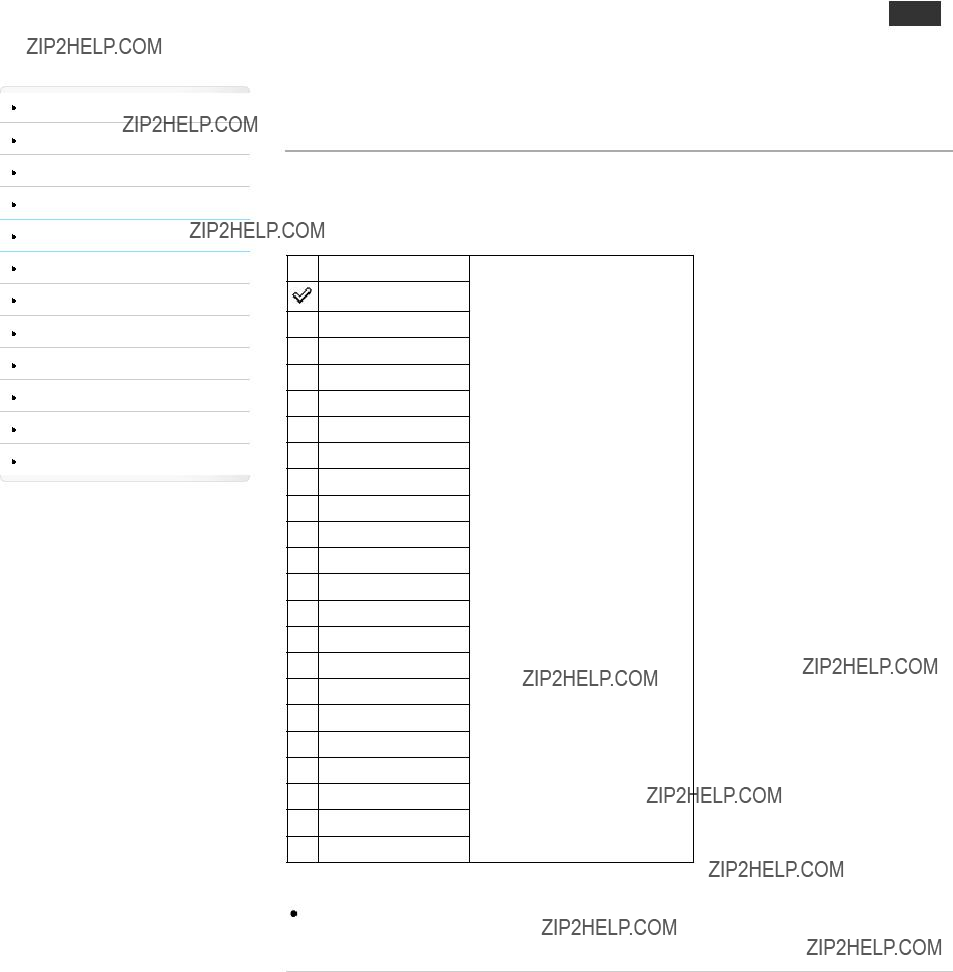
Search Print
Top page > Useful shooting functions > Using shooting functions > Func. of Left Button
Func. of Left Button
Allows you to select frequently used functions and assign them to the left button. 1. MENU 
 2
2  [Func. of Left Button]
[Func. of Left Button]  desired mode
desired mode
Exposure Comp.
Drive Mode
Flash Mode
Focus Mode
Autofocus Area
Smile/Face Detect.
Auto Object Framing
Soft Skin Effect
ISO
Metering Mode
Flash Comp.
White Balance Assigns the function that you set.
DRO/Auto HDR
Creative Style
Picture Effect
Image Size
Aspect Ratio
Quality
Memory
AEL toggle
AF/MF Control Toggle
Focus Magnifier
Ctrl with Smartphone
For details on [AEL toggle], [AF/MF Control Toggle] and [Focus Magnifier], see ???Func. of Center Button???. [Details]
Related Topic
Exposure Comp.
Drive Mode
Flash Mode
Focus Mode
Autofocus Area
Smile/Face Detect.
155

Auto Object Framing
Soft Skin Effect
ISO
Metering Mode
Flash Comp.
White Balance
DRO/Auto HDR
Creative Style
Picture Effect
Image Size
Aspect Ratio
Quality
Memory
Ctrl with Smartphone
 Back to top
Back to top
Copyright 2013 Sony Corporation
156

Search Print
Top page > Useful shooting functions > Using shooting functions > Func. of Right Button
Func. of Right Button
Allows you to select frequently used functions and assign them to the right button. 1. MENU 
 2
2  [Func. of Right Button]
[Func. of Right Button]  desired mode
desired mode
Exposure Comp.
Drive Mode
Flash Mode
Focus Mode
Autofocus Area
Smile/Face Detect.
Auto Object Framing
Soft Skin Effect
ISO
Metering Mode
Flash Comp.
White Balance Assigns the function that you set.
DRO/Auto HDR
Creative Style
Picture Effect
Image Size
Aspect Ratio
Quality
Memory
AEL toggle
AF/MF Control Toggle
Focus Magnifier
Ctrl with Smartphone
For details on [AEL toggle], [AF/MF Control Toggle] and [Focus Magnifier], see ???Func. of Center Button???. [Details]
Related Topic
Exposure Comp.
Drive Mode
Flash Mode
Focus Mode
Autofocus Area
Smile/Face Detect.
Auto Object Framing
157

Soft Skin Effect
ISO
Metering Mode
Flash Comp.
White Balance
DRO/Auto HDR
Creative Style
Picture Effect
Image Size
Aspect Ratio
Quality
Memory
Ctrl with Smartphone
 Back to top
Back to top
Copyright 2013 Sony Corporation
158

Top page > Useful shooting functions > Using shooting functions > MF Assist
MF Assist
Enlarges the image on the screen automatically to make manual focusing easier. This works in [Manual Focus] or [DMF] modes.
1.MENU 
 3
3  [MF Assist]
[MF Assist]  desired mode
desired mode
2.Turn the Control Ring to adjust the focus.
The image is enlarged 8.6 times. You can also enlarge the image 17.1 times by pressing  on the control wheel.
on the control wheel.
On Enlarges the image. You can set the enlarging duration using [Focus Magnif. Time].
Off Does not enlarge the image.
Notes
 You cannot use [MF Assist] when shooting movies.
You cannot use [MF Assist] when shooting movies.
Related Topic
Focus Magnif. Time
 Back to top
Back to top
Copyright 2013 Sony Corporation
160

 Back to top
Back to top
Copyright 2013 Sony Corporation
161
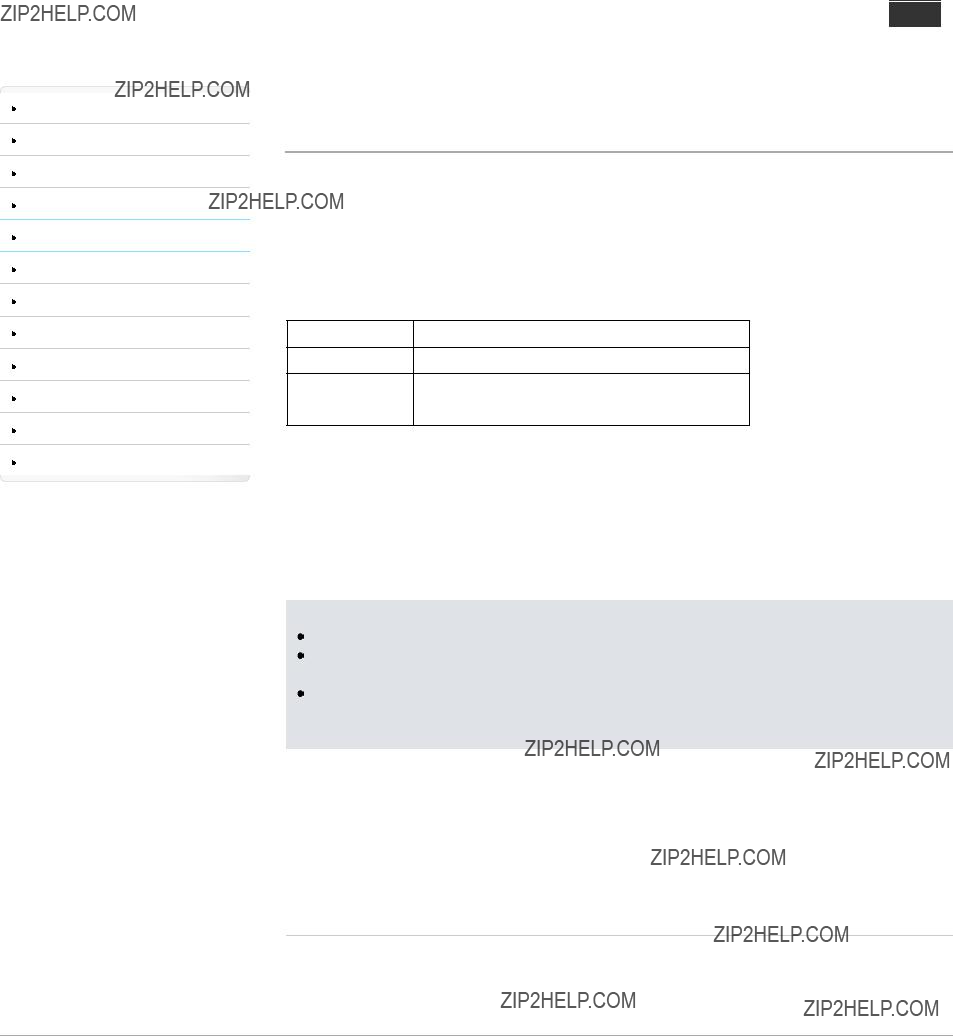
Search Print
Top page > Useful shooting functions > Using shooting functions > Face Registration
Face Registration
 New Registration
New Registration
 Order Exchanging
Order Exchanging
If you register faces in advance, the camera can detect the registered face as a priority when [Smile/Face Detect.] is set to [On (Regist. Faces)].
1. MENU 
 3
3  [Face Registration]
[Face Registration]  desired mode
desired mode
New Registration Registers a new face.
Order Exchanging Changes the priority of faces previously registered.
 New Registration
New Registration
1.MENU 
 3
3  [Face Registration]
[Face Registration]  [New Registration]
[New Registration]
2.Align the guide frame with the face to be registered, and press the shutter button.
3.When a confirmation message appears, select [Enter].
Notes
Up to eight faces can be registered.
Shoot the face from the front in a brightly lit place. The face may not be registered correctly if it is obscured by a hat, a mask, sunglasses, etc.
Even if you execute [Initialize], registered faces are not deleted. Even if you execute [Delete], the data for registered face will remain in the camera. To delete the data for registered faces from the camera, select [Delete All].
 Order Exchanging
Order Exchanging
1.MENU 
 3
3  [Face Registration]
[Face Registration]  [Order Exchanging]
[Order Exchanging]
2.Select a face for which you want to change the priority.
3.Select the priority level.
The smaller the number, the higher the priority.
Related Topic
Smile/Face Detect.
 Back to top
Back to top
Copyright 2013 Sony Corporation
163

164

Search Print
Top page > Useful viewing functions > Playback menu > Still/Movie Select
Still/Movie Select
Switches the display mode between still images and movies (View Mode). 1. MENU
 1
1  [Still/Movie Select]
[Still/Movie Select]  desired mode
desired mode
 (Folder View(MP4)) Displays
(Folder View(MP4)) Displays
 (AVCHD View) Displays
(AVCHD View) Displays
Viewing images taken with a different camera
This camera creates an Image Database File on a memory card for recording and playing images. Images not registered in the Image Database File may not be displayed correctly.
Register images recorded with other cameras by selecting MENU 
 1
1  [Recover Image DB]
[Recover Image DB]
to play them back on this camera.
Use a sufficiently charged battery to register images. If a battery with a low charge is used to register images, it may not be possible to transfer all of the data or the data may be corrupted if the battery charge runs out.
Related Topic
Recover Image DB
 Back to top
Back to top
Copyright 2013 Sony Corporation
165

 Back to top
Back to top
Copyright 2013 Sony Corporation
166

Top page > Useful viewing functions > Playback menu > Slide Show
Slide Show
Plays back images automatically.
Plays back only 3D images in [Slide Show] on a 3D TV connected to the camera.
1.MENU
 1
1  [Slide Show] The setting screen appears.
[Slide Show] The setting screen appears.
2.Select the desired setting.
3.[Enter] 
 on the control wheel
on the control wheel
4.Press  to exit [Slide Show].
to exit [Slide Show].
Repeat
Related Topic
MENU items not available for each view mode
 Back to top
Back to top
Copyright 2013 Sony Corporation
167

Search Print
Top page > Useful viewing functions > Playback menu > Image Index
Image Index
Selects the number of images to be displayed on the index. 1. MENU
 2
2  [Image Index]
[Image Index]  desired mode
desired mode
 Displaying images of the desired folder
Displaying images of the desired folder
 Back to top
Back to top
Copyright 2013 Sony Corporation
168
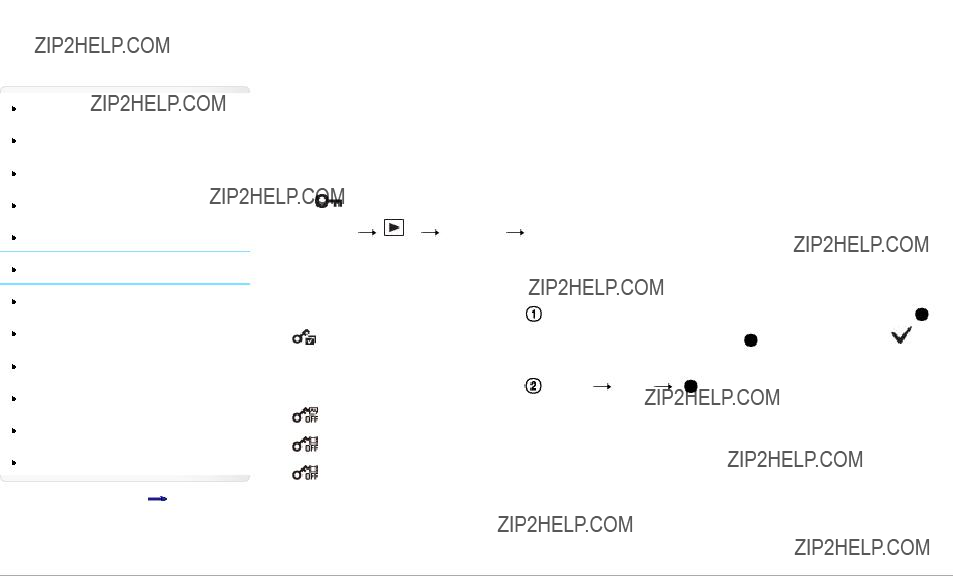
 Back to top
Back to top
Copyright 2013 Sony Corporation
169

Top page > Useful viewing functions > Playback menu > Specify Printing
Specify Printing
DPOF (Digital Print Order Format) is a function that allows you to specify the images of the memory card that you want to print out later.
DPOF Setup
 The
The  (Print order) mark cannot be added to movies.
(Print order) mark cannot be added to movies.
You can add a (Print order) mark to a maximum 999 images.
Related Topic
Printing still images
 Back to top
Back to top
Copyright 2013 Sony Corporation
170

Search Print
Top page > Useful viewing functions > Playback menu > Send to Smartphone
Send to Smartphone
 Transfer images to an Android smartphone with one touch
Transfer images to an Android smartphone with one touch
Allows you to transfer images to display on a smartphone.
Install the smartphone support application ???PlayMemories Mobile??? to your smartphone from the application store. If ???PlayMemories Mobile??? has already been installed on your smartphone, update it to the latest version.
For details on ???PlayMemories Mobile???, refer to the support website (http://www.sony.net/pmm/). 1. MENU
 1
1  [Send to Smartphone]
[Send to Smartphone]  desired mode
desired mode
2.Connect to the camera from your smartphone, using the information that appears on the screen when the camera is ready to be connected. Connection methods differ, depending on the type of smartphone. [Details][Details]
Notes
Options for image size are the size in which the image was shot, [2M] or [VGA] format.
To change the size of an image to be transferred to a smartphone, use ???PlayMemories Mobile???. Some images may not be played back on the smartphone depending on the data format.
RAW images are converted into JPEG images and then transferred. You cannot transfer AVCHD movies.
The camera shares the connection information for [Send to Smartphone] with a device that has permission to connect. If you want to change the device that is permitted to connect to the camera,
reset the connection information by pressing MENU 
 3
3  [SSID/PW Reset]. After resetting the connection information, you must set a smartphone. [Details]
[SSID/PW Reset]. After resetting the connection information, you must set a smartphone. [Details]
Transfer images to an Android smartphone with one touch
You can connect the camera to an NFC smartphone with just one touch, without the need for complicated settings, and transfer images.
171

1.Activate the NFC functions of smartphone.
2.Display a single image on the camera.
 You can use the NFC function only when
You can use the NFC function only when  (N Mark) is displayed on the screen.
(N Mark) is displayed on the screen.
3.Touch the camera to the smartphone.
The smartphone is connected to the camera, and ???PlayMemories Mobile??? is activated. The image being displayed on the camera is transferred to the smartphone.
Continue touching until ???PlayMemories Mobile??? starts (1 - 2 seconds). Touch after canceling sleep and the screen lock of the smartphone.
Touch the N mark of the smartphone to  (N Mark) of the camera. If there is no N mark on the smartphone, refer to the manual of the smartphone.
(N Mark) of the camera. If there is no N mark on the smartphone, refer to the manual of the smartphone.
and select the desired images. Wait for
About NFC
NFC (Near Field Communication) is a technology enabling
Notes
You cannot transfer images via NFC when the image index screen is displayed. If you cannot connect the smartphone and camera correctly, do the following.
Activate ???PlayMemories Mobile??? on the smartphone, then move the smartphone slowly around  (N mark) of the camera.
(N mark) of the camera.
If you have put a case on your smartphone, remove the case. If you have put a case on the camera, remove the case.
If you have attached a tripod to the camera, remove the tripod temporarily. Confirm that the NFC functions are activated on the smartphone.
When the camera is in Airplane mode, connection to a smartphone is not possible. Set [Airplane Mode] to [Off].
 Back to top
Back to top
Copyright 2013 Sony Corporation
172

 Back to top
Back to top
Copyright 2013 Sony Corporation
173

Search Print
Top page > Useful viewing functions > Playback menu > View on TV
View on TV
If the camera and TV are not connected using an HDMI cable, you can view images on a network- enabled TV by transferring the image from the camera. You may need to set the TV beforehand, depending on the model. For details, see the instruction manual of the TV.
1.MENU 
 1
1  [View on TV]
[View on TV]  desired device to be connected
desired device to be connected
2.When you want to play back images using slideshow, press  .
.
 To play back images manually, press
To play back images manually, press  /
/ .
.
 To change the device to be connected, press
To change the device to be connected, press  to select [Device list], and press
to select [Device list], and press  .
.
 Slideshow setting
Slideshow setting
You can change the settings for the slideshow by pressing  .
.
* The settings are effective only for BRAVIA TV which is compatible with the functions.
Notes
You can use this function on a TV that supports DLNA renderer.
You can view images on a
Displaying the images on the TV may take time.
 Movies cannot be shown on TV using
Movies cannot be shown on TV using
Related Topic
WPS Push
Access Point Settings
 Back to top
Back to top
Copyright 2013 Sony Corporation
174







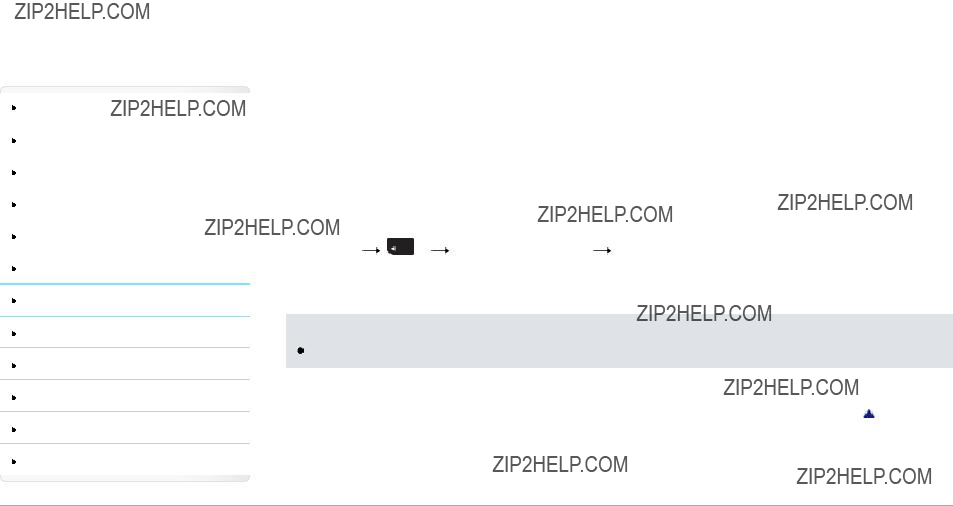








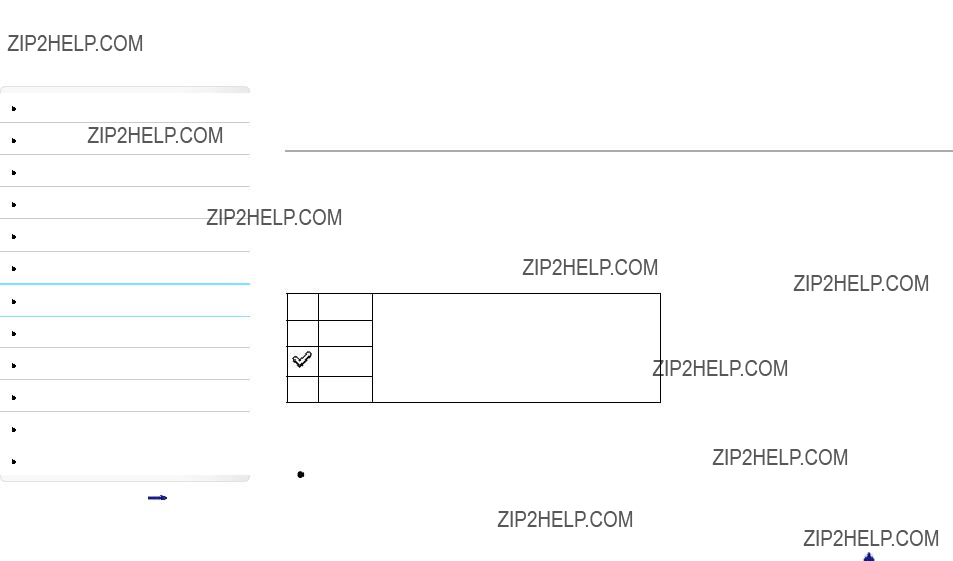




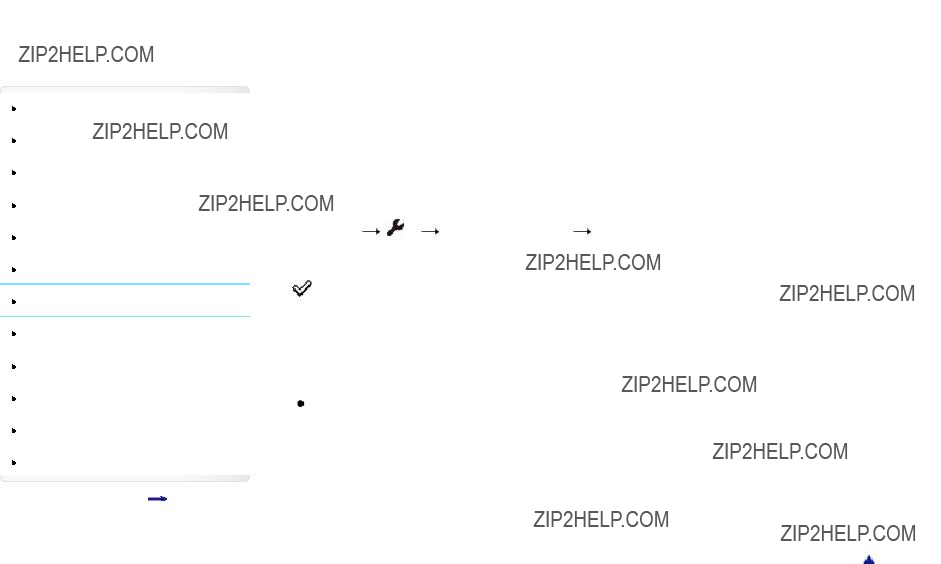






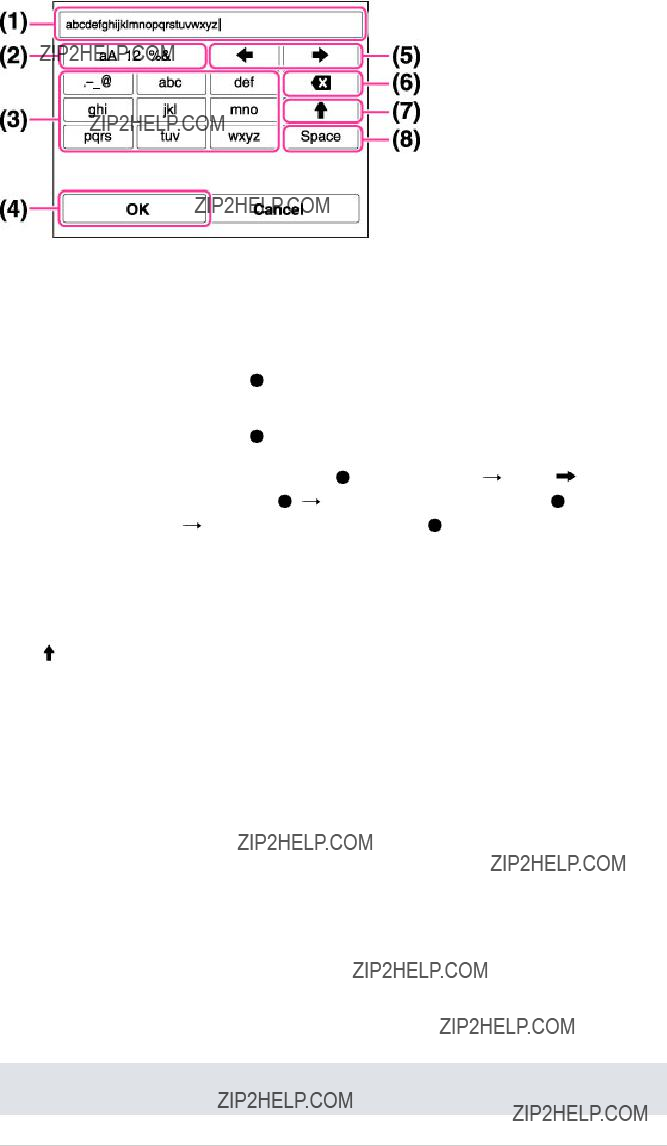

































The flash does not work.
You cannot use the flash in the following situations:
[Drive Mode] is set to
(Anti Motion Blur),  (Night Scene),
(Night Scene), 
 (Fireworks) or
(Fireworks) or  (High Sensitivity) mode is selected in [Scene Selection].
(High Sensitivity) mode is selected in [Scene Selection].
Shooting in [Sweep Panorama] mode  Shooting in movie mode
Shooting in movie mode
Set the flash to  (Pet),
(Pet),  (Gourmet),
(Gourmet),  (Landscape),
(Landscape),  (Sports Action) or
(Sports Action) or  (Sunset) mode. [Details]
(Sunset) mode. [Details]
Fuzzy white circular spots appear in images shot using the flash.
Particles (dust, pollen, etc.) in the air reflected the flash light and appeared in the image. This is not a malfunction. [Details]
The
The camera automatically adjusts the focus. Press and hold the shutter button halfway down. Focus adjustment may take some time when shooting a close subject.
 (Sports Action),
(Sports Action),  (Landscape),
(Landscape),  (Night Scene) or
(Night Scene) or  (Fireworks) mode is selected in [Scene Selection].
(Fireworks) mode is selected in [Scene Selection].
The date and time are not displayed on the screen.
 While shooting, the date and time are not displayed. They are displayed only during playback.
While shooting, the date and time are not displayed. They are displayed only during playback.
The F value and shutter speed flash.
 The exposure is incorrect. Correct [Exposure Comp.]. [Details]
The exposure is incorrect. Correct [Exposure Comp.]. [Details]
The image colors are not correct.
 Adjust [White Balance]. [Details]
Adjust [White Balance]. [Details]
 [Picture Effect] is selected. [Details]
[Picture Effect] is selected. [Details]
 Execute [Initialize] to reset settings to default. [Details]
Execute [Initialize] to reset settings to default. [Details]
The image is extremely bright or dark.
 Execute [Initialize] to reset settings to default. [Details]
Execute [Initialize] to reset settings to default. [Details]
Noise appears in the image when you view the screen in a dark place.
The camera is attempting to increase the visibility of the screen by temporarily brightening the image under conditions of low illumination. There is no effect on the recorded image.
You can see a dark shadow on the image.
Depending on the brightness of the subject, you may see a dark shadow when you change the aperture. This is not a malfunction.
The eyes of the subject come out red.
236


